





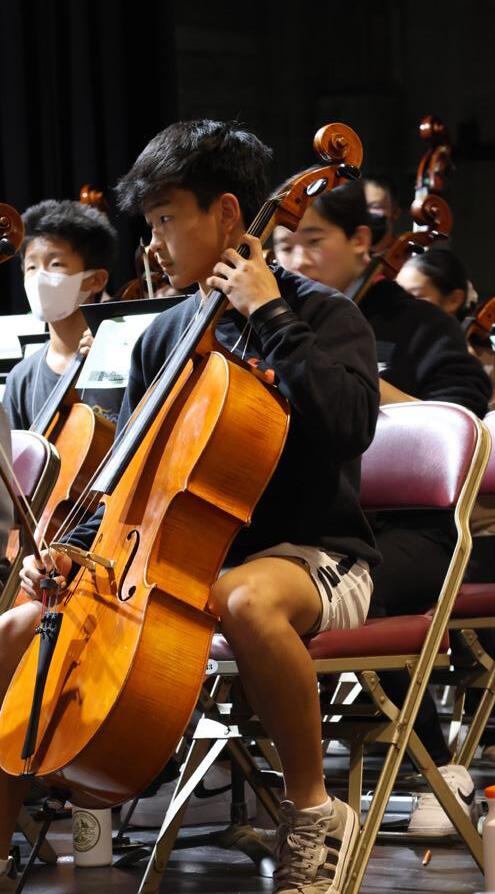

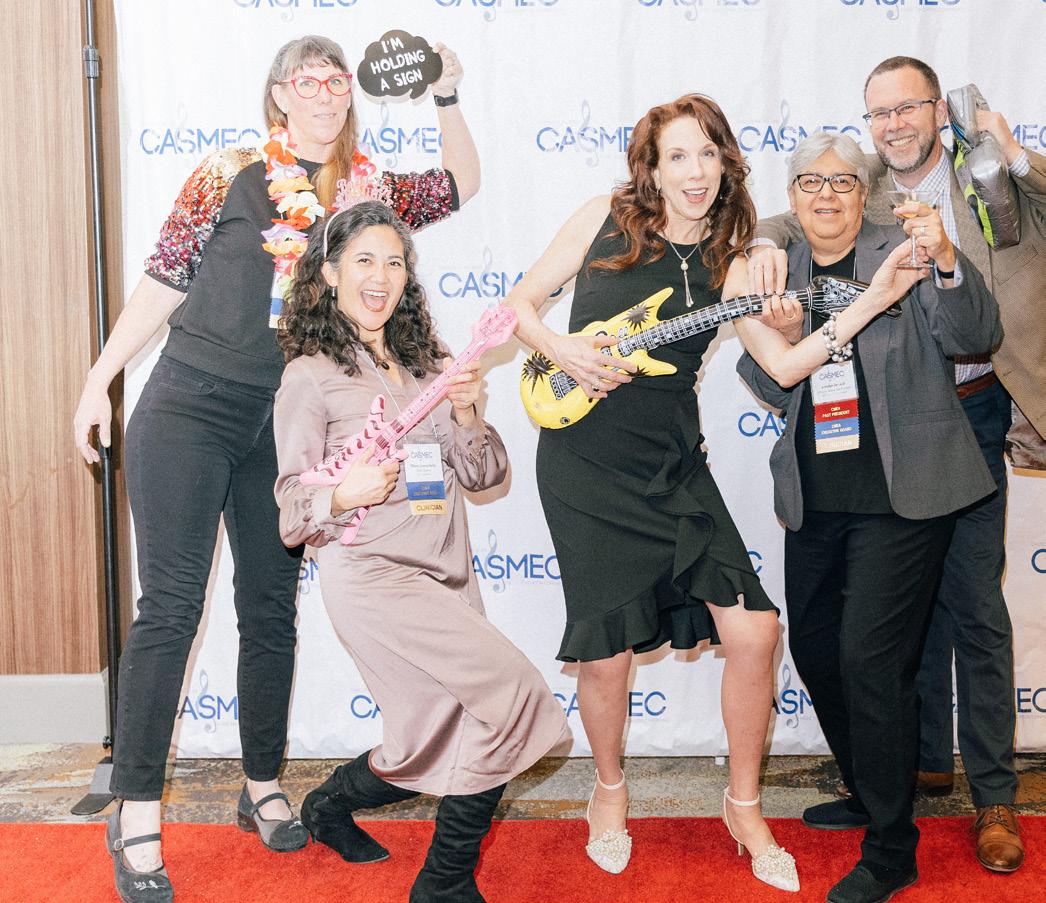


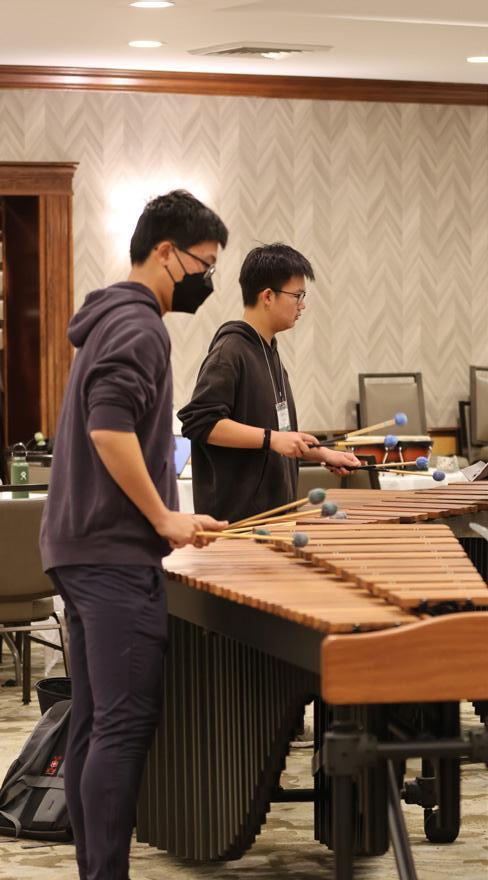

CME A Magazine SPRING ISSUE 2023 VOLUME 76 • NUMBER 3 SPRING 2023
Grades
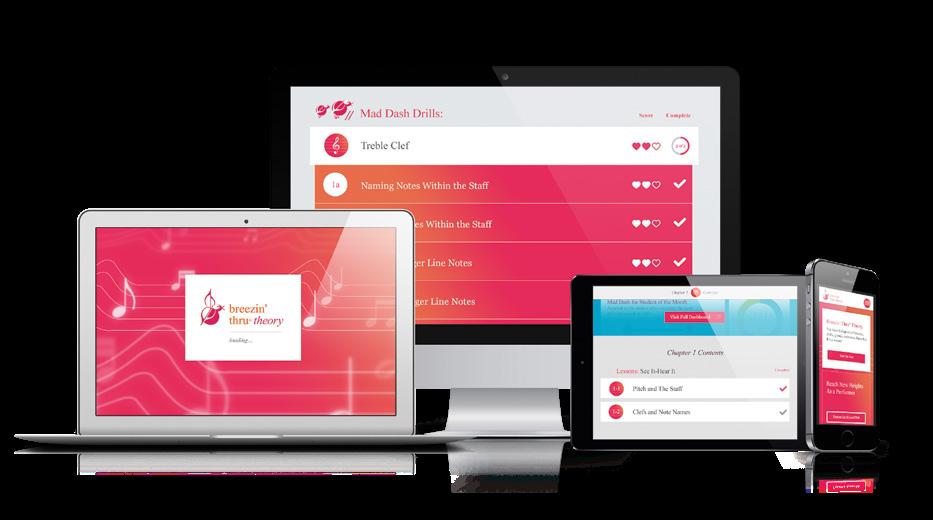
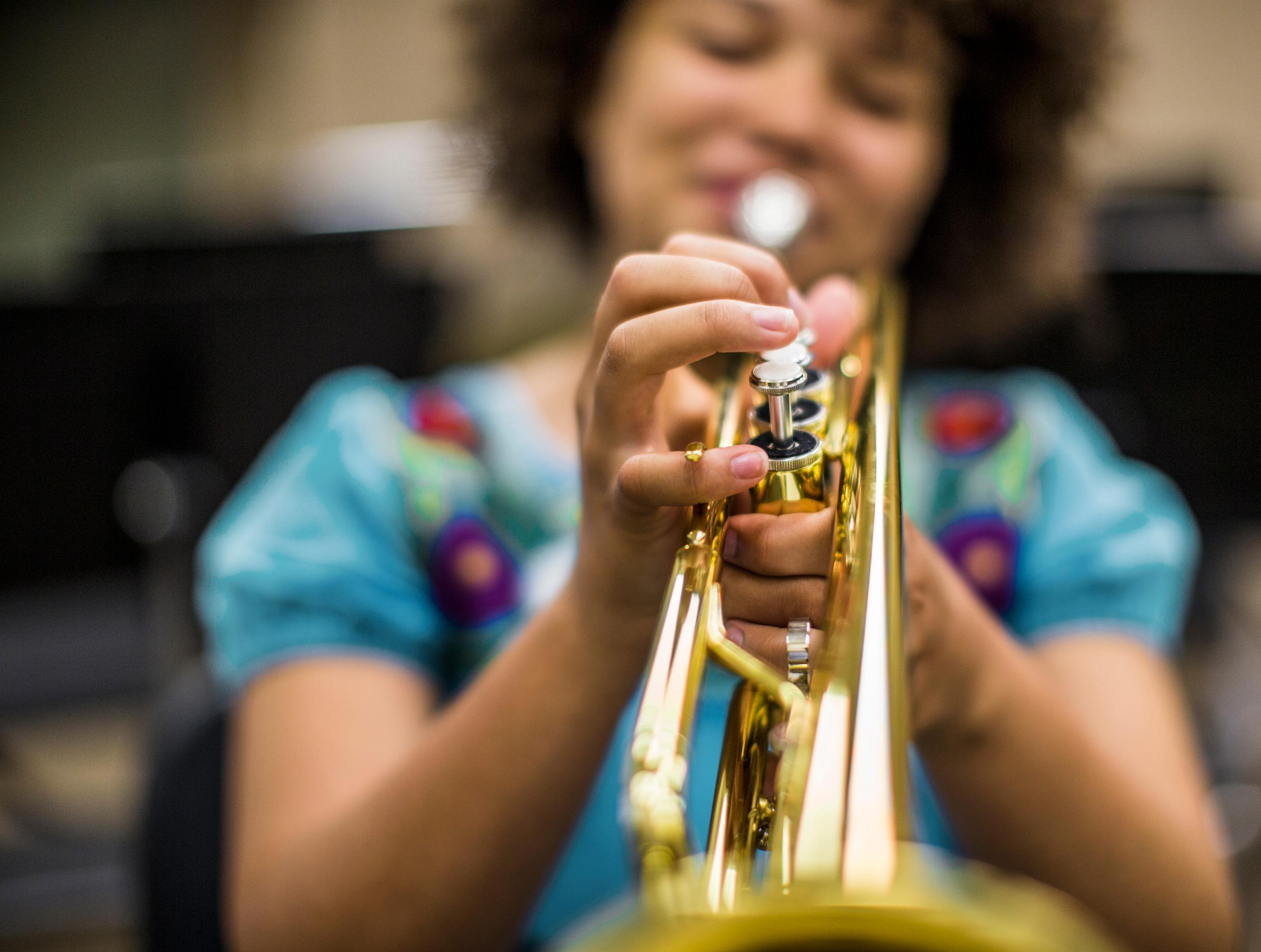
5-12
Grow Your Program! Fun for Kids, Easy for Teachers! Demo it today! breezinthrutheory.com/demo or 1-855-265-3805
When students build rapid response to music theory concepts, their sight reading and understanding go through the roof –and so do rehearsals! Level the playing field and accelerate your performance programs integrating Breezin’ Thru Theory, while keeping things fun. And, it frees up valuable class and marking time, so you can do what you love most – getting students excited about performing!
by
by
by

17
by Amy Lui, CMEA Secondary Music Representative

19 Bay Section
by Sandra Lewis, CMEA Bay Section President
19
by Patrick Neff, CMEA Capitol Section President

21 Central Section Update by Michael Tackett, CMEA Central Section President
22 Central Coast Section Update by Samuel Oh, CMEA Central Coast Section President
23 North Coast Section Update by Collin Kirkwood, CMEA North Coast Section President
24 Northern Section Update by Tanner Johns, CMEA Northern Section President
26 Southeastern Section Update by Dr. David Betancourt, CMEA Southeastern Section President
27 Southern Border Section Update by Dr. Jeff Maleci, CMEA Southern Border Section President
28 Southwestern Section Update by Dr. Tamara Thies, CMEA Southwestern Section President
30 CMEA Collegiate CouncilCASMEC Update by Daniel Crispino, Caitlin Cooper, and Victoria Guerrero, CMEA Collegiate Council
32 Using singing To Increase Literacy in Ensemble Classes by David Green, CBDA Director of Communications
The Executive Board of CMEA serves as the Editorial Committee. The observations and opinions expressed in any article in this magazine are those of the author and do not necessarily represent the official position of the Association. CMEA does not necessarily endorse any product or service advertised in this magazine.
President’s Message
Fennell, CMEA President 4 CMEA State Council 6 Become a Partner with CMEA 8 CASMEC Pictorial 10 Advocacy in Action 11 CASMEC PREVIEW - Featured Performing Ensembles
To Supplement or Supplant, That is the Question
Russ Sperling, CMEA Advocacy Representative
CASMEC 2023 Young Composers
Creating
Composition
Rural School Update
In This Issue 3
by Anne
12
15
Symposium
Dr. Lisa Crawford, CMEA
and
Representative 16
Jeremiah Jacks, CMEA Rural Schools Representative
Why Attending CASMEC Matters
Update
Capitol Section Update
Ad Index IFC Breezin' Thru Theory 5 Hayward La Honda 39 Music for All 11 Namm Foundation 29 Nick Rail Music 14 Sacramento Jazz Education Foundation 11 San Jose State University 36 Sonoma State University 14 University of Portland 7 World Projects 13 Yamaha 18 Young People’s Chorus CMEA Magazine is published quarterly (Fall, Winter, Spring, Summer) by CMEA. Graphic Designer: Adam Wilke Editors: Holly MacDonell and Trish Adams Business Manager: Trish Adams CMEA Administrative Office Mailing Address: 2417 N 11th Ave, Hanford, CA 93230 Office: 559 904–2002 E-mail: cmea@calmusiced.com Website:
Rates
advertising
calmusiced.com/communication/magazine/ publication-guidelines
www.calmusiced.com
and
information available here:
Orchestrate Success in Your Career... JOIN CMEA+. Visit www.nafme.org. CMEA is a federated state association of the National Association for Music Education.
In This Issue (continued)
34 Teacher Voice by Zack Pitt-Smith, CMEA Urban Schools Representative
34 Collegiate Spotlight
34 Citizen DJ, from the Library of Congress by Holly MacDonell, CMEA Music Education Through Technology Representative and Vice President
35 New Ideas to Ponder: 2023 CMEA Research & Educational Projects Poster Session by Dr. Ruth Brittin, CMEA Research and Higher Education Representative
37 News from the California Choral Directors Association by Dr. Christopher Peterson, CCDA President

CMEA Past Presidents
2020-2022 Armalyn De la O, San Bernadino
2018-2020 John Burn, Cupertino
2016-2018 Scott Hedgecock, Fullerton
2014-2016 Michael D. Stone, Bakersfield
2012-2014 Russ Sperling, San Diego
2010-2012 Norman Dea, Walnut Creek
2008-2010 Jeff Jenkins, Chula Vista
2006-2008 Cheryl Yee Glass, Danville
2004-2006 Rob Klevan, Pacific Grove
2002-2004 Sam Gronseth, Paradise
2000-2002 George DeGraffenreid, Fresno
1998-2000 Dennis L. Johnson, Salinas
1996-1998 Jay D. Zorn, La Crescenta
1994-1996 Don Doyle, Pasadena
1992-1994 Bill Adam, Roseville
1990-1992 Carolynn Lindeman, Greenbrae
1988-1990 L. Leroy Roach, Walnut Creek
1986-1988 John L. Larrieu, Portola
1984-1986 Vivian M. Hofstetter, Bakersfield
1982-1984 David S. Goedecke, Stockton
1980-1982 Charles L. Freebern, San Diego
1978-1980 Henry Avila, Monterey
1976-1978 Mary C. Reed, Elk Grove
1974-1976 Marlow Earle, Lakewood
1972-1974 Louis Nash, La Crescenta
1970-1972 Anthony L. Campagna, Foster City
1968-1970 Judd Chew, Sacramento
1966-1968 Kenneth D. Owens
1964-1966 Keith D. Snyder, Davis
1962-1964 Gibson Walters, San Jose
1960-1962 Douglas Kidd
1957-1960 Joseph W. Landon, Fullerton
1955-1957 Harold Youngberg, Oakland
1953-1955 Fred Ohlendorf, Long Beach
1951-1953 George F. Barr
1949-1951 Elwyn Schwartz
1947-1949 Clarence Heagy, Fresno
37 Higher Education Music Education by Dr. Kara Ireland D'Ambrosio, CMEA Higher Ed Music Education Supervisor Representative
38 Spring Update, CODA by Tiffany Ou-Ponticelli, CODA President
CMEA Hall of Fame Award Recipients Honoring Lifetime Achievement in Music Education
2022 - Marlene Mudge
2020 - Stephen Luchs
2019 - Judi Scharnberg, Jeri Webb
2018 - Dr. Lawrence Stoffel, Dean Hickman
2017 - Dr. Edward Harris, Michael Corrigan, James Mazzaferro
2016 - Dr. Robert Halseth, Rosemarie Krovoza, Rick Meyer
2015 - Dale Anderson, Ann Marie Haney, Dr. Thomas Lee
2014 - Jon Christian
2013 - Orrin Cross
2012 - Gayane Korkmazian, 2012; Gerald E. Anderson, 2012;
2011 - David Whitwell
2010 - Nicholas Angiulo, Vincent Gomez
2009 - Kem F. Martinez, Carl W. Schafer, Robert W. Lutt
2008 - Duane Weston
2007 - John Larrieu, Mary Val Marsh, Barbara Cory, Bill Ingram
2006 - Carolynn Lindeman, Joe Foster, Paul Shaghoian
2005 - Frances Benedict, L. Leroy Roach, Silvester McElroy, Jerry Kirkpatrick
2004 - Robert Greenwood, Arthur Huff, Lyle Stubson, Lois Vidt
2003 - John Farr, Thomas Eagan
2002 - Larry Johnson, Mary Louise Reilly
2001 - William Hill, Helynn Manning, Wesley “Colonel” Moore
2000 - Vivian Hoffstetter, F. John Pylman
1999 - Lawrence Sutherland
1998 - Chuck Schroeder
1997 - Dean Semple
1996 - Burl Walter Jr.
1994 - Jerry Moore
1992 - Mike Pappone
1991 - David Goedecke
1987 - Marlowe Earle
1985 - Arthur Dougherty
1983 - William Burke
1981 - Aubrey Penman
1979 - Steve Connolly
1977 - Howard Swan
1975 - Russell Howland
President's Message
by Anne Fennell, CMEA President
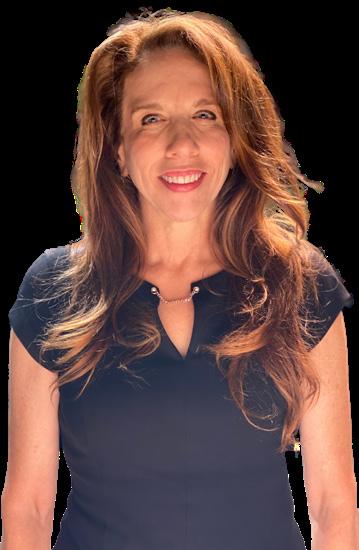

It’s been a busy 5 weeks for CMEA with CASMEC February 15-19 and Stand Up 4 Arts in Sacramento on Tuesday, March 21; and we're filled with passion and support for music education!
I enjoyed seeing so many of you in Fresno at CASMEC, along with the many wonderful sessions and our collective commitment to learn, connect, and share. There is always a palpable energy when music educators come together. I want to share a few moments that made this conference such a special event. In addition to exceeding our conference attendance from last year, we held our first-ever joint Kickoff Celebration and Awards event with our CASMEC partners: CAJ, CBDA, CCDA, and CODA. It was a time to catch-up, honor, and recognize dedicated and distinguished members, while enjoying an organization's signature cocktail.
We also held our first-ever elementary classroom music performances in the convention center lobby, provided by local elementary students and ensembles.It was wonderful to feel the happy anticipation of elementary students preparing to perform, see beaming parents' smiles as they watched their children sing and play, and to hear music floating through the lobby. I think the most powerful moment for me was watching a father in the front row of the standing audience, mouth the words of every song to his daughter, throughout the entire performance. Afterwards, I made a point to tell him how much I enjoyed seeing his support of her singing and he said, “We worked so hard on each song. She practiced and practiced at home and I’m so proud of her. I just wanted to make sure she had all the words so she could be confident.” Yes, music and performing music is oftentimes a family affair because the ownership is authentic and parents want to see their children succeed and feel the joy of accomplishment. We will continue this tradition of elementary performances in the lobby at our annual conference, so keep a look out for performance requests coming this fall.
In addition to our celebration and the lobby performances, we revealed our new CMEA Strategic Plan during our Thursday General Session. This was co-created by our state-wide leadership over a 5-month period, and you can view the plan here.
This Strategic Plan, along with our Diversity, Equity, Inclusion, and Access (DEIA) Policy will guide our planning, work, and organizational decisions moving forward. It will be our guiding documents for all organizational decisions. I’m so proud of the dedication and work that every leader in our organization completed - from the Executive Board to our Section Presidentsand that our collective vision is clear: to ensure that All California students have equitable access to UTK- 12 music education that embraces diverse and inclusive music-making throughout California. I’m confident that our core values and mission to serve our members in
the state will make this a reality.
In our General Session, which we will now call our Welcome Session in 2024 (thank you, Tiffany Barry), we invited several TRI-M students to share What Music Means to Me. Adia Soriano from Harmony Magnet Academy (Zander Smith, Music Educator) shared, “....It means that I have an outlet to express my emotions and ideas, and a supportive community where I can feel a sense of belonging. To me, music is a way to communicate with the world and bring people together in ways you can't elsewhere.” Samantha Chand (also from Harmony Magnet Academy - Zander Smith, Music Educator) shared, “Music means a lot to me. I believe music can change a person’s mood and brighten someone’s day. And that is why it is so important to me. If you can change someone’s day just by singing or playing a certain song or piece. I can’t imagine how much we can affect the world with what we have at our fingertips.” How inspiring it was to hear these students share their thoughts!
Our session closed with an update from our Western Division President, Scott Hedgecock and an inspiring keynote by Rafa Sardina, sponsored by Focusrite. Rafa clearly highlighted the many benefits of music and the skills that we inherently bring to our students, and the music industry, for those possible and future employees sitting in our classes. With every sharing of ideas and thoughts, I was reminded that In the midst of our many, seemingly endless, demands and student needs, we need to intentionally pause to remind ourselves that every action we take and every word we speak is contributing to a human’s development that will forever be a part of their creative and unique life. We’re so fortunate to have music as the medium in this journey!
After February we moved our focus to our first in-person Stand Up 4 Arts Day in Sacramento, since 2019! After months and months of planning, we were thrilled to welcome student performances and sharing from CAEA, CDEA, CETA, and of course CMEA, kicked off the morning that led into our Noontime Welcome where each arts organization president spoke on behalf of arts education. We collectively shared a California Senate Resolution created by Senator Anthony J. Portantino, officially declaring March 21, 2023 as Stand Up 4 Arts Education Day. During the day CMEA board members and industry partners from NAMM visited the offices of assembly members and senators to share the benefits of music and music education, offer thanks for their support, and discuss future needs. Our most urgent and number one ask was for clarity surrounding Prop 28 as we navigate this new proposition and its implementation. A huge shout out to John Brashier, our CMEA Stand Up 4 Arts Coordinator who helped organize the performances and who kept the run-of-show moving!
I continue to be proud of all that we do in our organization for teachers and students, and I was reminded that we are so fortunate to work in a state that appreciates the value of arts education and that we as educators are able to reach out to our representatives, voice our needs, and engage in conversations.
Now we find ourselves in April and nearing the end of our 2223 school year! May your spring be filled with fantastic culminating events that leave you proud of all that you’ve given to your students and the growth of their learning and your program.
Spring Issue 2023 3
CMEA State Council
CMEA EXECUTIVE BOARD
CMEA President Anne Fennell afennell@calmusiced.com
CMEA President-Elect
Chad Zullinger czullinger@calmusiced.com
CMEA Vice President Holly MacDonell hmacdonell@calmusiced.com
CMEA Secretary Tiffany Barry tbarry@calmusiced.com
CMEA Immediate Past President Armalyn De La O adelao@calmusiced.com
CMEA OFFICE cmea@calmusiced.com 2417 North 11th Avenue Hanford, CA 93230 559 587-2632
CMEA Executive Administrator Trish Adams cmea@calmusiced.com 559 904-2002
CMEA Administrative Assistant Heather Adams hadams@calmusiced.com 559 410-2425
CMEA Legislative Advocate Martha Zaragoza Diaz lobbyist1.mzd@gmail.com
SECTION PRESIDENTS
CMEA Bay Section President Sandy Lewis slewis@pausd.org
CMEA Capitol Section President Patrick Neff patrick.s.neff@gmail.com
CMEA Central Section President Michael Tackett michaelt@cos.edu
CMEA Central Coast Section President Sam Oh samuel.oh@salinasuhsd.org
CMEA North Coast Section President Collin Kirkwood collinkirkwood1@gmail.com
CMEA Northern Section President Tanner Johns tjohns@chicousd.net
CMEA Southeastern Section President Dr. David Betancourt dbetancourt@cerritos.edu
CMEA Southern Border Section President Dr. Jeff Malecki jmalecki@sandiego.edu
CMEA Southwestern Section President Dr. Tamara Thies Tamara.Thies@csulb.edu
NAfME OFFICERS
NAfME President
Scott Sheehan 1806 Robert Fulton Drive Reston, VA 22091 800 336-3768
NAfME Western Division President Scott Hedgecock shedgecock@calmusiced.com
COUNCIL OF REPRESENTATIVES
CMEA CAJ Representative Barb Catlin barbcatlin@gmail.com
CMEA CASMEC Coordinator Francisco Marquez fmarquez123@me.com
CMEA CBDA Representative Jeff Detlefsen DetlefsenJ@gmail.com
CMEA CCDA Representative Dr. Christopher Peterson cpeterson@fullerton.edu
CMEA CCDA Choral Leadership Academy Coordinator John Sorber johnso@cos.edu
CMEA CODA Representative Tiffany Ou-Ponticelli touponticelli@pausd.org
CMEA Advocacy Day Performance Coordinator John Brasier jbrashie@egusd.net
CMEA Advocacy Representative Russ Sperling sperlingruss@gmail.com
CMEA Collegiate Representative Dr. Diana Hollinger dhollinger2006@yahoo.com
CMEA Collegiate Council Representative Andrew Shousha andrewshousha1230@gmail.com
CMEA Creating and Composition Representative Dr. Lisa Crawford lisacrawfordmusic@gmail.com
CMEA CTA Liason Alan Underwood
CMEA DEIA Representatives Jonathan Raman Jraman85@gmail.com
CMEA Diverse Learners Representative Regan Lambert rlambert@emcsd.org
CMEA Elementary Music TK-5/6 Representative Sal Rios rioss@gfusd.net
CMEA Global Music Education Representative Dr. Will Coppola wcoppola@usc.edu
CMEA Higher Ed Music Education Supervisor Representative Dr. Kara Ireland D’Ambrosia Kara.IrelandDAmbrosio@sjsu.edu
CMEA Higher Education and Research Representative Dr. Ruth Brittin rbrittin@pacific.edu
CMEA Innovations Representative Dr. Megan Foley mfoley@polytechnic.org
CMEA Mentorship Program Chairperson Ryan Duckworth DuckworthMusic@gmail.com
CMEA Music Supervisors Representative Brad Van Patten BradVanPatten@iusd.org
CMEA Music Education through Technology Representative Holly MacDonell hmacdonell@calmusiced.com
CMEA New Teacher Representative (5 or less years) Nico Salum nicolosalum@gmail.com
CMEA Retired Members Representative Rita Zigas-Brown rzigas.brown@gmail.com
CMEA Rural Schools Representative Jeremiah Jacks jeromejacks30@gmail.com
CMEA Secondary Music 6-12 Representative Amy Lui amy.lui@polyhigh.org
CMEA Social Media Representative Holly MacDonell hollymacdonell@gmail.com
CMEA State Band and Orchestra Festival Coordinator John Burn jburn@calmusiced.com
CMEA State Choral Festival Coordinator Stacey Kikkawa choralfestival@calmusiced.com
CMEA State Solo and Ensemble Festival Coordinator Cheryl Yee Glass cglass@srvhs.org
CMEA Tri-M Representative Troy Trimble troyatrimble@gmail.com
CMEA Urban Schools Representative Zack Pitt-Smith zackpittsmith@gmail.com
4 CMEA Magazine

Become a Partner Wtih CMEA
Gold Level Sponsors Gold Partner - Annual Cost: $650
• Website listing with logo and web link on corporate sponsorship page of website
• Exclusive Gold Partner access to CMEA direct sponsored email pricing+
• Company name designation with URL link in each CMEA Magazine
• 25% discount on all CMEA Magazine Advertising
• Company name and link as gold sponsor on CMEA state festival programs
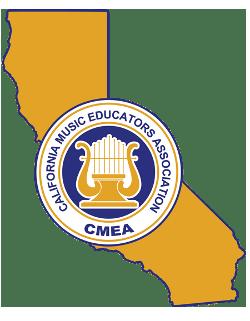
+see sponsored email marketing options below
Silver Partner - Annual Cost: $400
• Company name designation with URL link in each CMEA Magazine
• 15% discount on all CMEA Magazine Advertising
• Website listing with web link on corporate sponsorship page of website
• Company name and link as silver sponsor on CMEA state festival programs
Bronze Partner - Annual Cost: $250
• Company name designation with URL link in each CMEA Magazine
• Website listing with web link on corporate sponsorship page of website
• Company name and link as bronze sponsor on CMEA state festival programs


+Direct Sponsored Email (Gold Partner Exclusive)
Reach your customers directly! As a Gold Corporate Partner, you can now have exclusive access to our members through CMEA sponsored emails. Each month, CMEA will send up to two (2) sponsored emails on behalf of our Gold Corporate Partners. Corporate Partners may submit content and formatting to CMEA, who will distribute your email to the members of your choice. Contact a staff member today for more information. Availability is limited. All email content is subject to approval by CMEA. Rates excluded from discounts.
Sponsored Emails
We will send a promotional email to our membership on your behalf. Sponsored emails are only available for our Gold-level Corporate partners. Pricing below is for Gold-level Corporate members; all others will need to factor in the price of a Gold partnership also.

Pricing per Email (March - October)
• One (1) email to all Full Active Members: $350
• One (1) email to any segment (i.e. band, choral, orchestra, elementary): $250
Pricing per Email (November - February)
• One (1) email to all Full Active Members: $500
• One (1) email to any segment (i.e. band, choral, orchestra, elementary): $350
6 CMEA Magazine

Thanks for Attending CASMEC2023


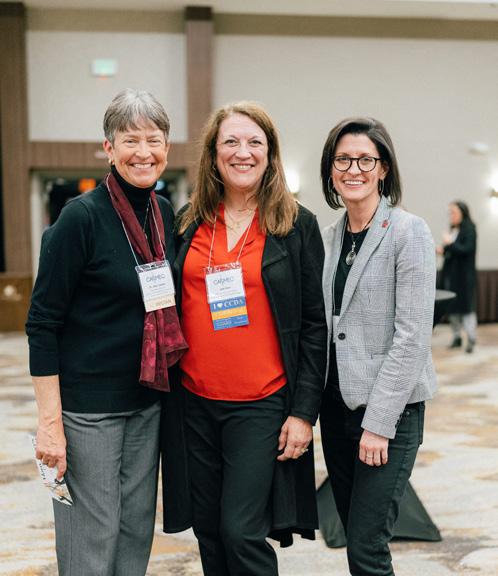



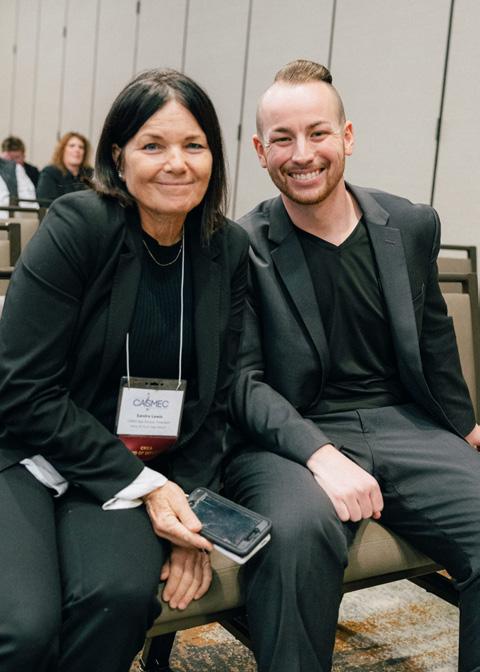
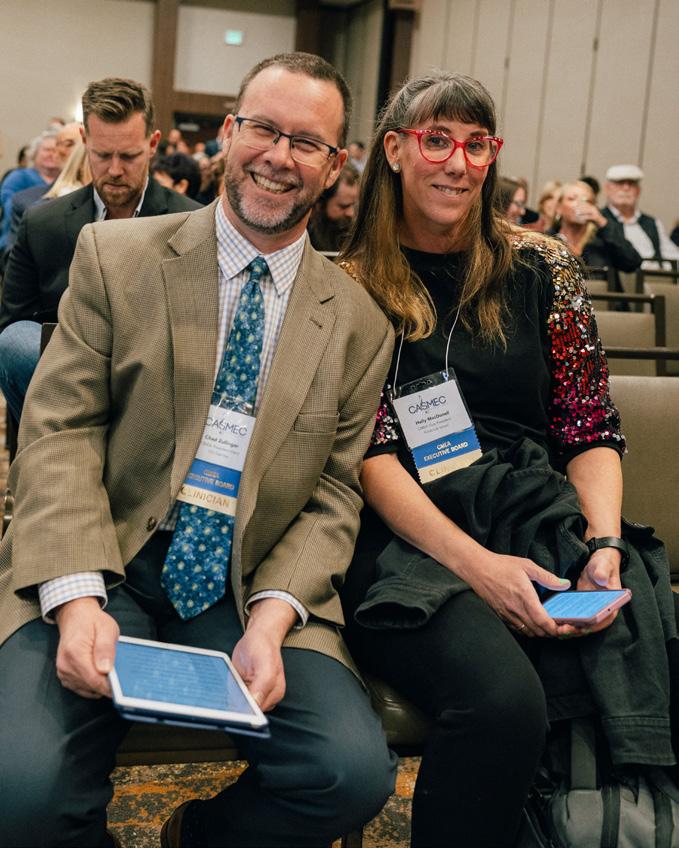
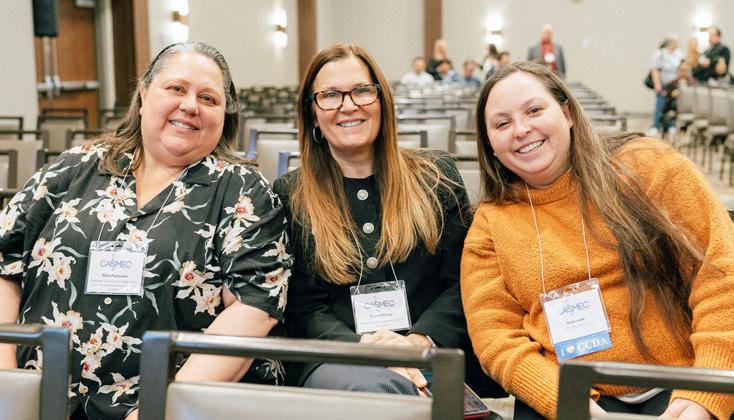

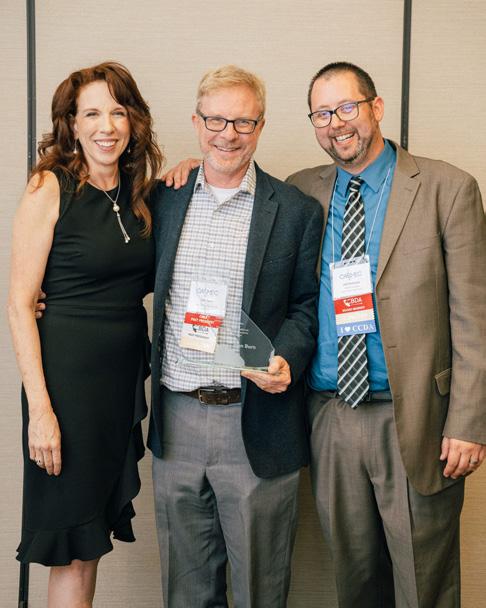
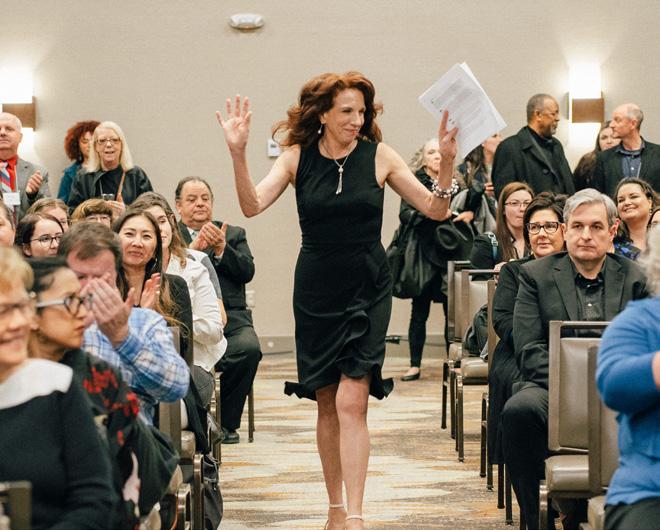
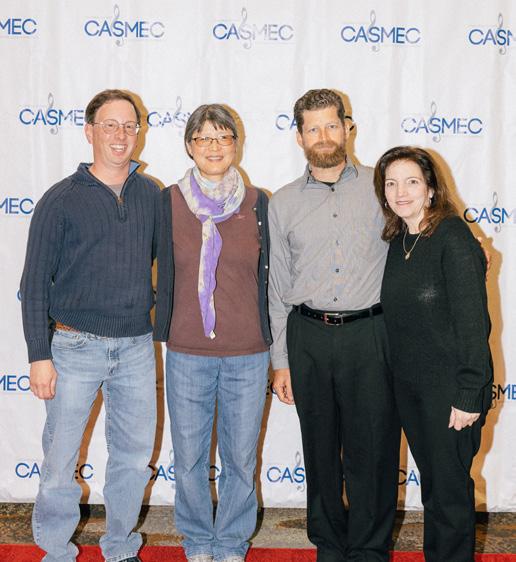

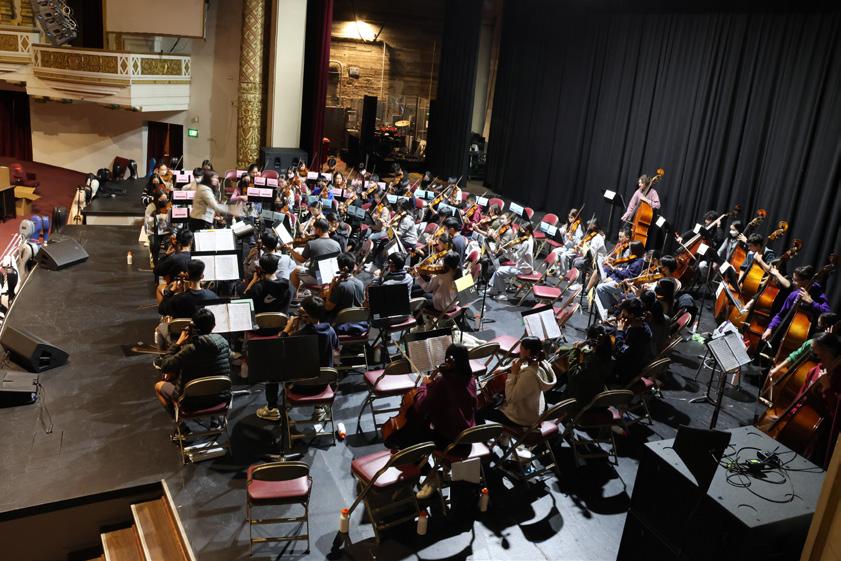





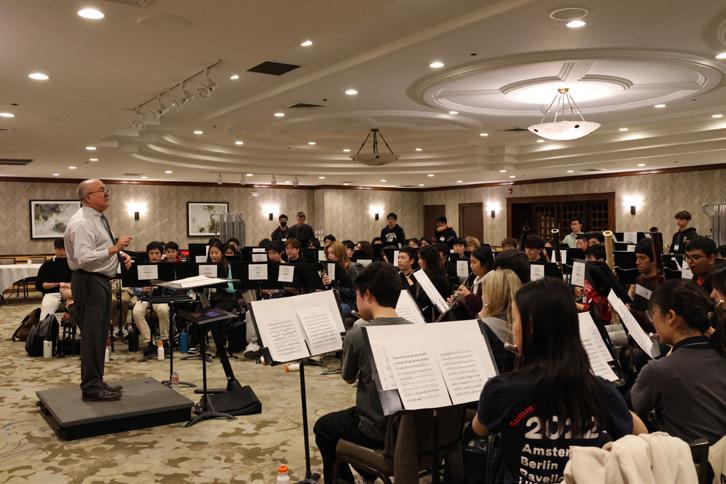
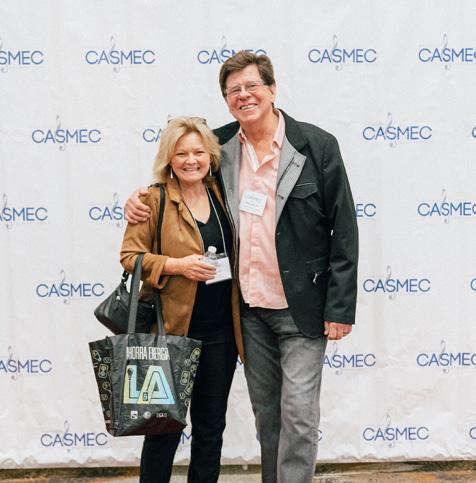
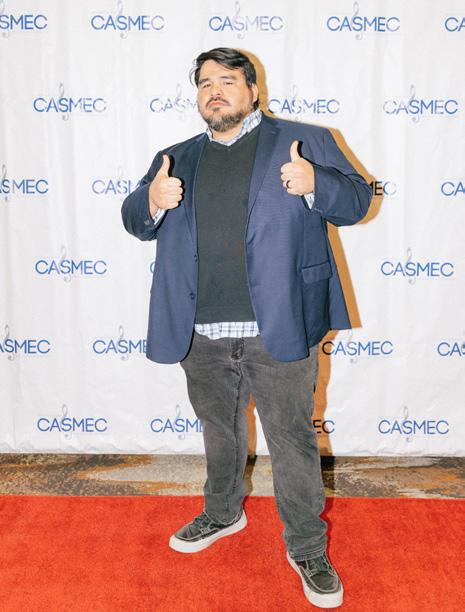



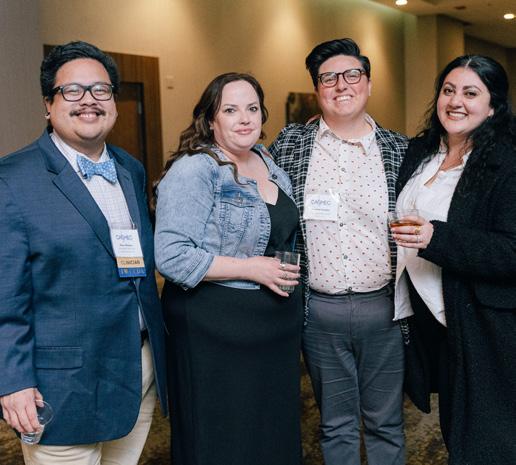



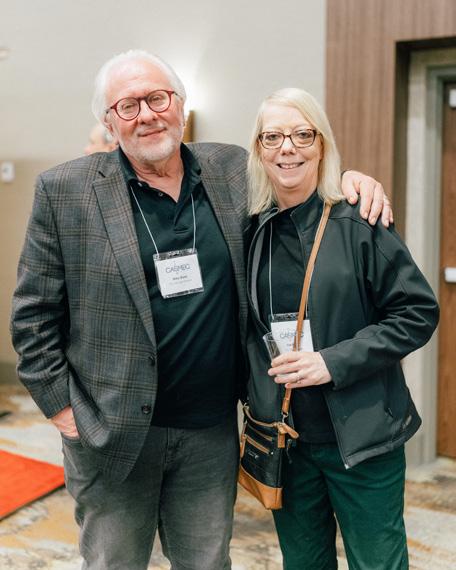
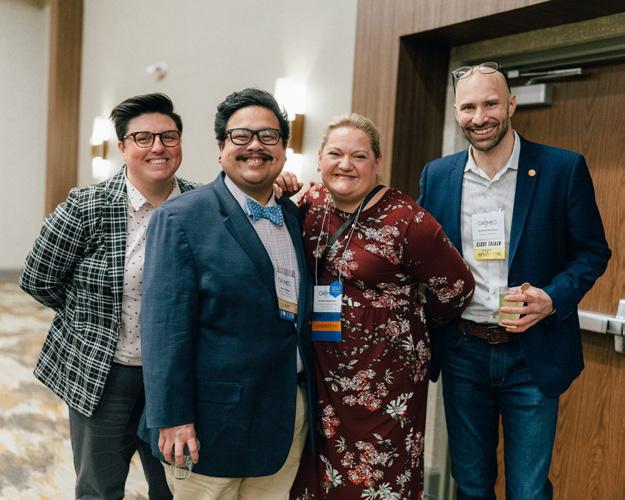
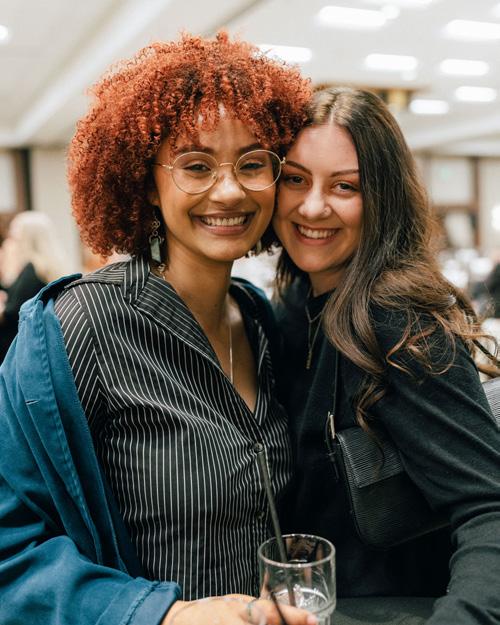

See You Next Year!!
Advocacy in Action!!
Stand Up 4 Arts Education day at the state Capitol!
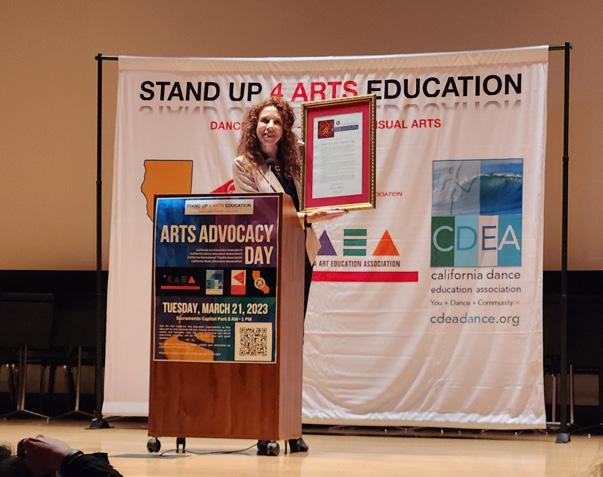
3-21-23
California Music Educators Association (CMEA), California Educational Theatre Association (CETA), California Dance Education Association (CDEA), California Art Education Association (CAEA).



In our first SU4AE in-person event in 3 years, it was filled with dance, music, and theatre performances - a wonderful display of arts education students! Our advocacy team had visits with Assemblymembers, Senate staffers, and aides, sharing the power of the arts, a few needs, and gratitude for their support.
Education
The State CMEA: California Music Educators Association Choral Festival is back!!
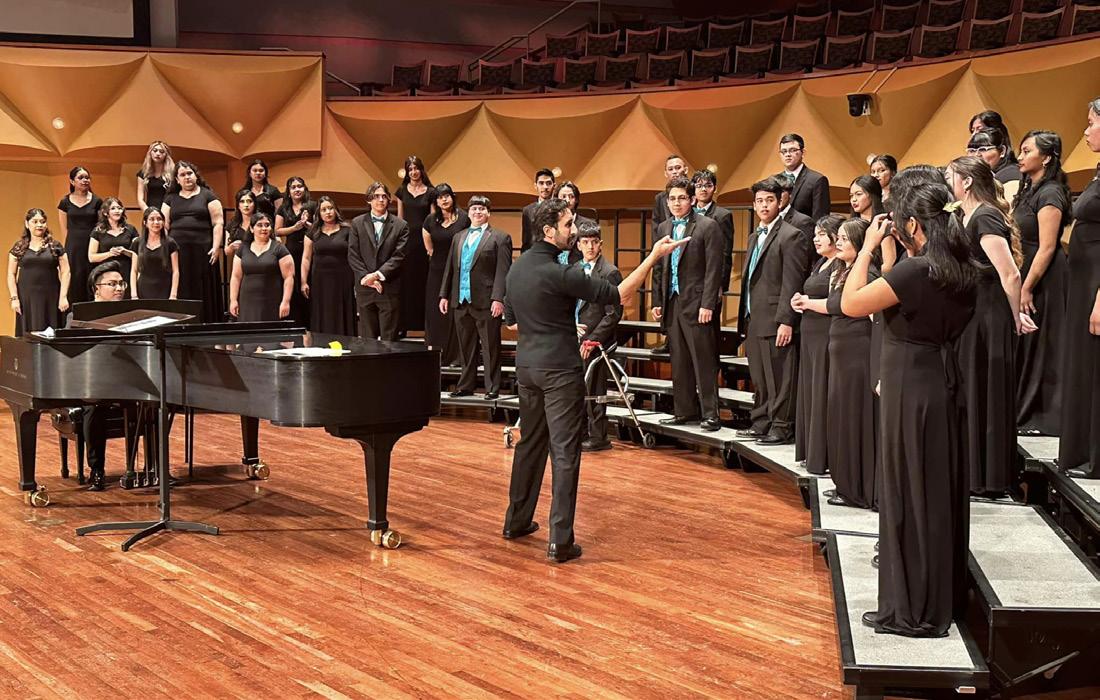
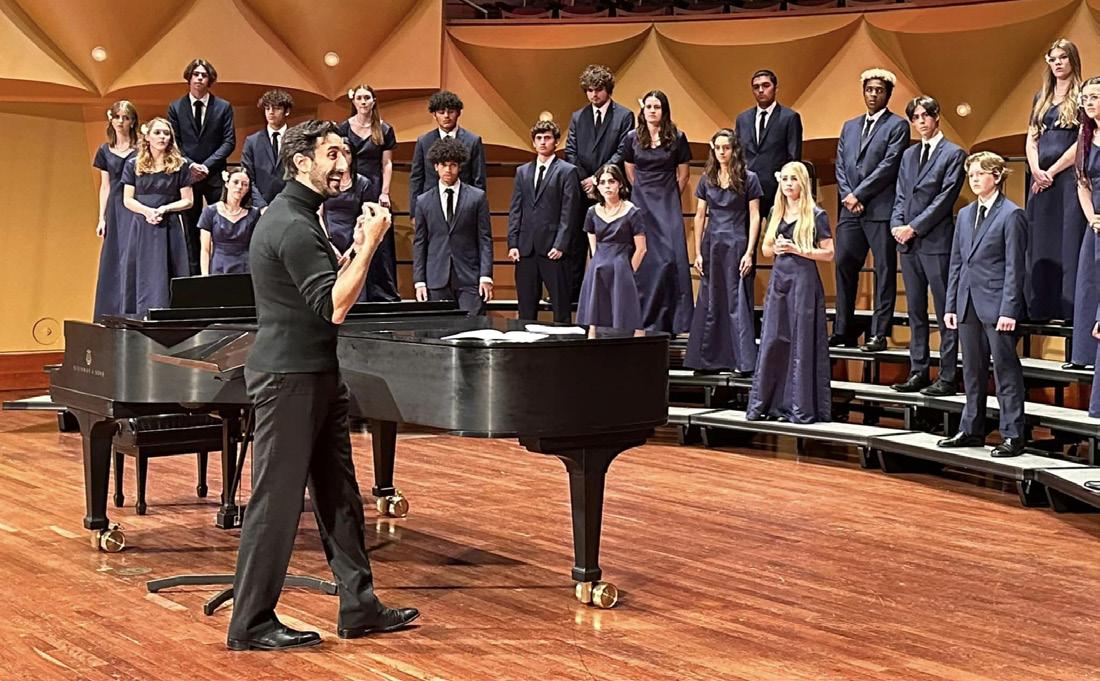
CMEA hosted the Choral Festival at Meng Concert Hall at Cal State Fullerton. Such beautiful music was made by all of the groups! Clinics were presented by Mrs. Julie Dana (Western ACDA President Elect), Arian Khaefi (Dir of Choral Studies SDSU Music Majors ), Christopher Peterson (Dir of Choral Music Ed Cal State Fullerton & California Choral Directors Association - CCDA President). Thank you Tricia Gibbs Adams and huge congrats to StaceyKikawa for taking this on!

10 CMEA Magazine
CMEA President, Anne Fennell speaks at Stand Up 4 Arts
Anne Fennell, Chad Zullinger, Holly MacDonell, Dave Gerhart (NAMM), and Martha Zaragoza Diaz (CMEA Lobbyist) gather at Stand Up 4 Arts Education
Stacey Kikkawa, CMEA Choral Festival Coordinator and Trish Adams

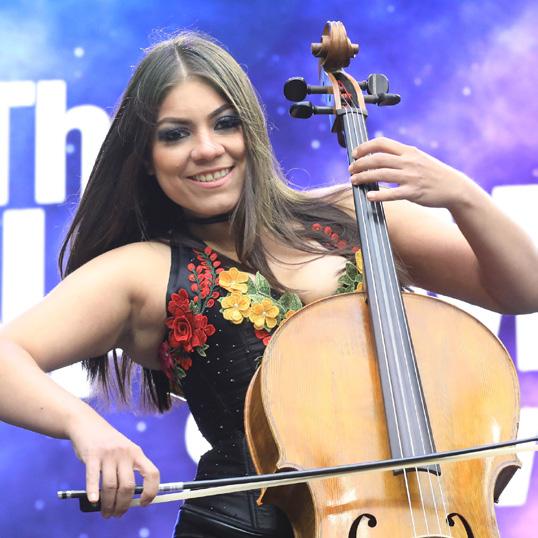




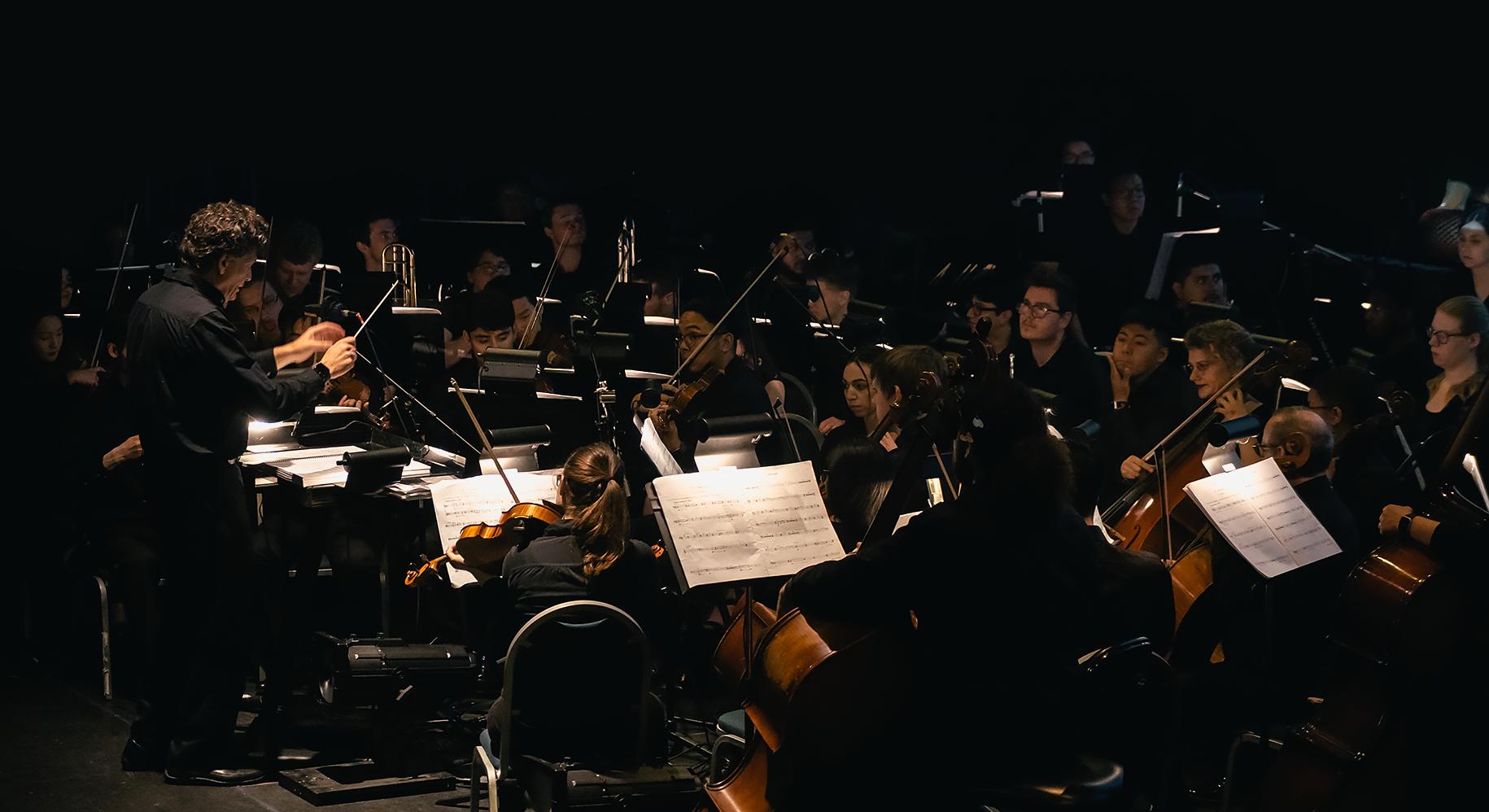
PEOPLE PRODUCTS POSSIBILITIES A New World of Join the global music community in Southern California for The 2023 NAMM Show, April 13 -15. The NAMM Foundation will feature its signature programs including Music Education Days, GenNext, the Nonprofit Management Institute, and Million More Music Makers—which ensures that there is something for everyone! namm.org/attend San Jos é State University Music, BA Music, MM Music, BM CONCENTRATIONS IN Composition Jazz Studies Music Education Performance DEGREES MORE INFORMATION AT SJSU.EDU/MUSIC MUSIC@SJSU.EDU 408.924.4673
To Supplement or Supplant, That is the Question Putting
Prop. 28 in Context
by Russ Sperling, CMEA Advocacy Representative
• Supplant [ suh-plant, -plahnt ] to take the place of (another), as through force, scheming, strategy, or the like. (source: dictionary.com)
For those of us who have spent time in the federal title world (as in Title I, Title IV part A, etc.), these two words are familiar. The law says that you cannot use Title I funds to fund something you’re already doing – they need to go to something extra.

Fortunately, the author of Proposition 28, the recentlyapproved arts and music education funding measure passed by California voters, Austin Beutner, understands the importance of these words in the context of education funding. He used strong and familiar language to reinforce that the intent of Prop. 28 is to add opportunities for our state’s students in the visual and performing arts, not to provide a source of funding that could be diverted to shore up funding for other purposes.
Unfortunately, we have already heard of districts and schools trying to do exactly what is not the intent of Prop. 28, to swap out, or supplant, by excessing arts and music teachers and then “hiring them back” with Prop. 28 funds. Austin, a former superintendent of Los Angeles Unified School District, will tell you that this is not allowed.
Is the language in the Prop strong enough to really make this illegal? We think so, but we are also all still waiting for the “rules,” or guidance from the California Department of Education (CDE) that will make things more clear. As of my writing of this article in early March, we are still waiting for CDE to tell us more. In early March an email was circulated among school finance personnel up and down the state quoting a CDE official as saying that it will be “a good long while” before any allocations go out.
Regardless of this lack of guidance, we as a profession need to be watching how the 977 school districts in California are handling supplement vs. supplant, and we have some arguments to make.
1. Intent. The clear stated intent of Prop. 28 is to add arts education in schools, not to pay for what is already going on. This is the will of the voters who passed Prop. 28 by a margin of 64.4% – the highest passage rate for an education initiative in the state’s history. School district personnel have a fiduciary responsibility to be good financial stewards of taxpayer dollars and to expend funds based on the will of the people. Supplanting Prop. 28 funds amounts to subverting democracy.
2. Prop. 28 does not exist to solve Prop. 98 problems. Because many districts and schools are experiencing declining enrollment or expiring COVID emergency funds, some school leaders may have an attitude that Prop. 28 funds can “come to the rescue” to bridge these shortfalls. Everyone in our state’s public schools needs to understand that a unique aspect of Prop. 28 is that for the first time since the minimum guaranteed funding initiative of Prop. 98 passed in 1988, Prop. 28 actually adds more funding to schools beyond the Prop. 98 guarantee. The Prop. 98 guarantee represents about 40% of the state’s overall budget. Prop. 28 funds come from the “other side,” the 60% of the state general fund outside of the Prop. 98 guarantee. Using these additional state dollars to fund existing programs is definitely not what California’s voters approved this past November.
3. Prop. 28 mirrors federal title language. As someone who has gone through the process of being audited for the correct use of Title I funds, I can tell you that that process is very exhaustive (if a bit painful to endure). Schools and districts marching down the road of supplanting could be in for a shocking surprise when they are asked to return funds that are misspent (yes, this really does happen), assuming the CDE guidelines are as strong as we think they will be.
Ever since I was CMEA president ten years ago, I have been imploring our profession to “pay attention.” With so much at stake, this is definitely a time to monitor how districts spend their Prop. 28 dollars, and to engage in advocacy when they are not allocated appropriately.
12 CMEA Magazine
• Supplement [ verb suhp-luh-ment ] something added to complete a thing, supply a deficiency, or reinforce or extend a whole
EVEN TEACHERS NEED TEACHERS
The Yamaha Educator Suite (YES) gives you access to a wealth of professional development opportunities and resources. YES brings you into a network of like-minded colleagues, experts and professionals who want to share their real-world experiences. You’ll also receive valuable tips on advocacy assistance, program health support and much more. Let us help you raise the bar. Go to Yamaha.io/educatorsCAMEA2

EMPOWER EMPOWER EXPAND. EXPLORE.
SET YOUR CREATIVITY FREE.
In our close-knit community, the guidance of dedicated faculty raises the bar on your talent while giving you freedom to explore new skills.

Visit
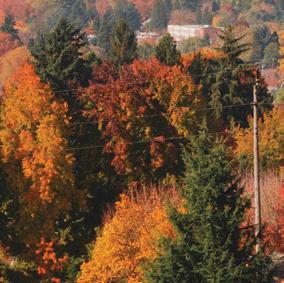

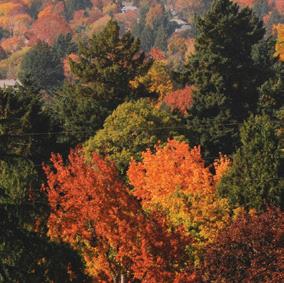

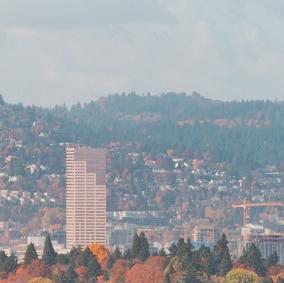

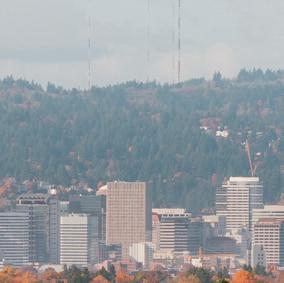





For More Information
Teagarden Jazz camp
Teagarden Jazz Camp
Registration is underway for the 37th annual Teagarden Jazz Camp at Sly Park, CA. Students ages 12 through 20 receive daily one-on-one and ensemble instruction,with emphasis on improvisation, plus nightly performances and end-of-camp concert. Two one-week sessions, July 24-29 and July 31–August 5. Students can apply online at www.sacjazzcamp.org or call Camp Director Bill Dendle at 916-804-9470. SCHOLARSHIPS ARE AVAILABLE!

sacJeF InsTrumenT maTch

Do you have students who cannot afford their own instrument? If so, have them apply online at https://sacjef.org/instrument-match/. Restricted to students in the greater Sacramento region, and subject to available inventory.
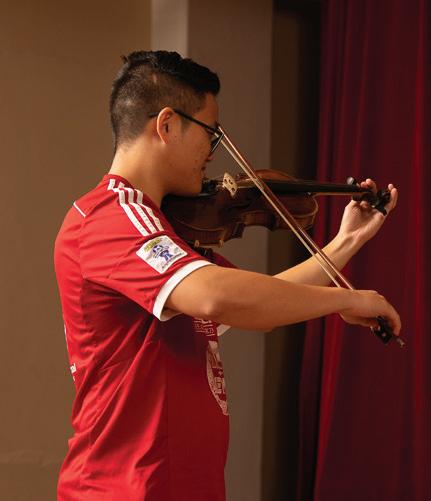



The Lesson Bank
The perfect tool for Music Educators dealing with online teaching. FREE videos available on a multitude of topics, suitable for beginner to advanced, student or adult. Check it out at www.sacjef.org

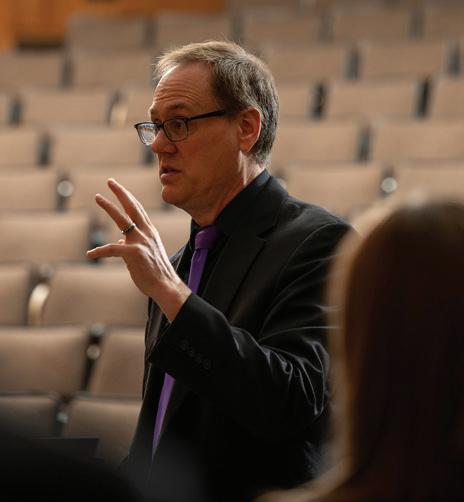

Educators Across Northern California THE LESSON BANK WE TEACH. YOU LEARN. FREE ONLINE COURSES. NI STRUMENT MAT C H Visit info@sacjef.org • (916) 571-5533 • P.O. Box 661763 • Sacramento, CA 95866 501c3 EIN 91-1776322
Partnering With Music
up.edu/music or contact us at upmusic@up.edu | 503.943.7228
CASMEC 2023 Young Composers Symposium
by Dr. Lisa A. Crawford CMEA Creating and Composition Representative
Thank you to the music educators and students who participated in this year’s CASMEC 2023 Young Composers Symposium! What an incredible array of different creative styles. I appreciated all of the students in Zoom and in-person for the conference. Students’ and educators’ excitement and extraordinary participation was noteworthy! Please see the Program for students and educators who participated.

Thank you, Amy Lui, for your Keynote, Nurturing and Empowering Student Creativity through Community and Industry Relations. We hope to hear more from you in the coming years about the explorations of your ideas. Thank you, Dr. Alexander Koops, for your support and efforts for the Young Composers Symposium! And thank you, CMEA, for your support of this work on behalf of students who create music.
As I prepared for Young Composers Symposium this year, music teachers asked about what types of music would be accepted. I have been asked about this frequently and finally realized that the word “composition” can feel misleading.

The Young Composers Symposium is about all creative works K-16 students are writing. This does not imply 21st century classical music styles only. Any project your student would like to submit is welcomed. Music educators may work with students who strongly present in creating music of their own, with and without lessons. All students and all music are welcomed!
I hope you will contact me during this next year if you have a student or students who would like to present in the annual Young Composers Symposium. We accept outcomes of your creating and composition lesson plans on video, songs, contemporary digital music, sound designs, and notated orchestral and band works.
For CASMEC 2024 Young Composers Symposium, we will have an independent session for presentation of K-5 creating and composing lesson plans on video. We have several music educators interested in participating in this and hope you will join us!
Please keep in touch with me over the coming year if you have questions (lisacrawfordmusic@gmail.com). Students and educators may attend our Creating and Composition Meetings held 2-3 times each year via Zoom. Watch social media and email for notifications. I want you to be a part of the conversation about what works for students beginning to explore their creative musical natures! See you next year!
Spring Issue 2023 15
Rural Schools Update
by Jeremiah Jacks, CMEA
I am thrilled to fill the position of Rural Schools Representative. I’ve been teaching in rural areas for most of my 24 years in music education. I’m looking forward to exploring how I can best serve our students and music educators in California. It was wonderful to connect with some Rural School Educators at CASMEC recently. There are amazing people doing awesome work in our rural areas.
I have begun some research into some of our remote rural areas in mid-California (south of Gardnerville, heading down and past Coleville), River Delta Unified School District where their one school district serves students in three counties, and El Dorado, Amador and Calaveras Counties. In reaching out to these districts, I’ve further confirmed things we already know. One thing we have in common in rural schools is often, the lack of accountability. Where in suburban or urban schools you have neighboring schools to keep up the standard, to help educate the community, and even VAPA coordinators and veteran educators in the larger districts to encourage a high quality education in music, rural areas often lack these supports. Of course Urban and Suburban schools face their own challenges. I think this is an area where we in the rural areas of California find need.
Often in rural schools, a successful music program is most reflected in the strength of the music educator. This is true of any music program, of course, but with large parent booster groups and larger music teams like you find in many larger school districts, there’s still added support. In rural schools, you are often alone. From time to time, you find a small team that is doing amazing things, like the fine folks in Parlier, just south of Fresno. There is a group of four music educators making a HUGE difference for that community. They are pretty lucky. It’s not often a rural school district attracts enough qualified music educators to form such a fantastic team. Indeed, positions often go unfilled because it is difficult to get folks out to more remote areas of California. More about the wonderful things happening in Parlier and other rural areas of our state in my next article.
I am also reflecting on what makes our community unique, and how diverse a “rural area” can be. I currently serve the Loomis Union School District community as a TK-8 music educator at two of our six schools. The vast majority of students attending the two schools I serve come from high-income households, with mostly large ranch homes with 1+ acre parcels. Another school in
our district enrolls far more students from low-income households than the rest in our district. Another is up the hill, even smaller and has a deaf/hard-of-hearing program imbedded in their curriculum where students are bused in from all over Placer County. In other words, communities, rural or otherwise, can still look very different, just over the hill. Urban, Suburban and Rural schools are incredibly diverse, and it would be a mistake to place assumptions on any school based on whether they are in the sticks, in the “burbs” or in the shadow of tall buildings. However, in finding common ground we can build a larger community while learning from our differences.
One thing most of us struggle with in rural areas is that sense of isolation from the rest of our music educator community. I hope to soon schedule a Zoom meeting for our Rural Music Educators, probably in April. It would be a great time to connect, share and build our larger community.
I’m learning a lot, and there’s a LOT more of California left to start looking into. I’ll be reaching out for help from key leaders in CMEA. Another need we have is that accountability piece, and support for small schools that may not have the pathway toward a quality education in music for their students. When talking with one of the office staff in Coleville, she said they’d talked about interest in providing music for their students, but they didn’t know how to schedule it They already have a culinary program they are very proud of that works well for their community. How do they fit in music, and where do they find an educator willing to move to the other side of the Sierras away from any city or even large town? Knowing the story and the struggle is important if we are going to reach kids beyond the hills, or far between them. I won’t be able to do this on my own, so I hope to work with some amazing people to build a grassroots movement, researching and advocating, supporting and designing.
Here’s what I’d love to get from all of you rural folks out there (and friends of all of us rural folks): share your story with me! Let me know what’s going on in your neck of the woods. I’ve taught in the rural areas of farmland in the central valley, small valleys beyond the Golden Gate Bridge, on up into some remote areas in the mountains. I’ve seen some amazing things and some crazy things. Share your amazing and crazy things with me. What are your successes? What are you struggling with? How can CMEA best serve you?

16 CMEA Magazine
Rural Schools Representative
Why Attending CASMEC Matters
by Amy Lui, CMEA
Secondary Music Representative
In one of the first years coming back to being in person at CASMEC, there were a lot of much needed in-person connections. Such connections were not just a way for us to embrace years-long friends or to meet new people but to pass on information that otherwise would not translate meaningfully in a digital, virtual manner. For instance, I had the wonderful opportunity to dine with some music teachers of the Lodi Unified School District (Lori Yates, Chelsie Chan, Mary Guida and Shane Park) where they were able to address questions and concerns about Prop 28 with me, including bouncing ideas and ways that this new funding may impact their programs.
Lastly, for those who may be new to teaching at a middle or high school or have never attended CASMEC before, I would like to share these resourceful tips from Sophia Cho, a former NAfME Collegiate Chapter President for Cal State University Northridge and first-year instrumental and choral music teacher in Los Angeles Unified School District’s Vista Middle School:

• You don’t have to attend a session every hour. You may feel overwhelmed with all of the sessions that are offered! My first year, I felt like I needed to attend EVERYTHING! What that resulted in was exhaustion and an oversaturated brain (no processing time!). My advice? Create your CASMEC schedule early and leave time for yourself to visit the Exhibit Hall, grab a bite to eat, and/or meet up with colleagues/network. Give yourself permission to process and reflect upon the information you are learning - it will lead to a deeper understanding and internalization of the information.
• Practice your networking skills here. If you are an introverted person like me, make an effort to step outside of your comfort zone and network with others. I have found that the music educator community is genuine and supportive no matter where you are in your music teaching development. With this being said, introduce yourself to the presenters, ask questions, make connections with vendors in the Exhibit Hall, and attend the CASMEC Gala/Kickoff Night.
• Encourage your fellow music education colleagues to attend CASMEC at least once. If you have a NAfME Collegiate Chapter on campus, plan early (October at the latest) and fundraise/collaborate with your school to get the registration fees, traveling, and other costs covered.
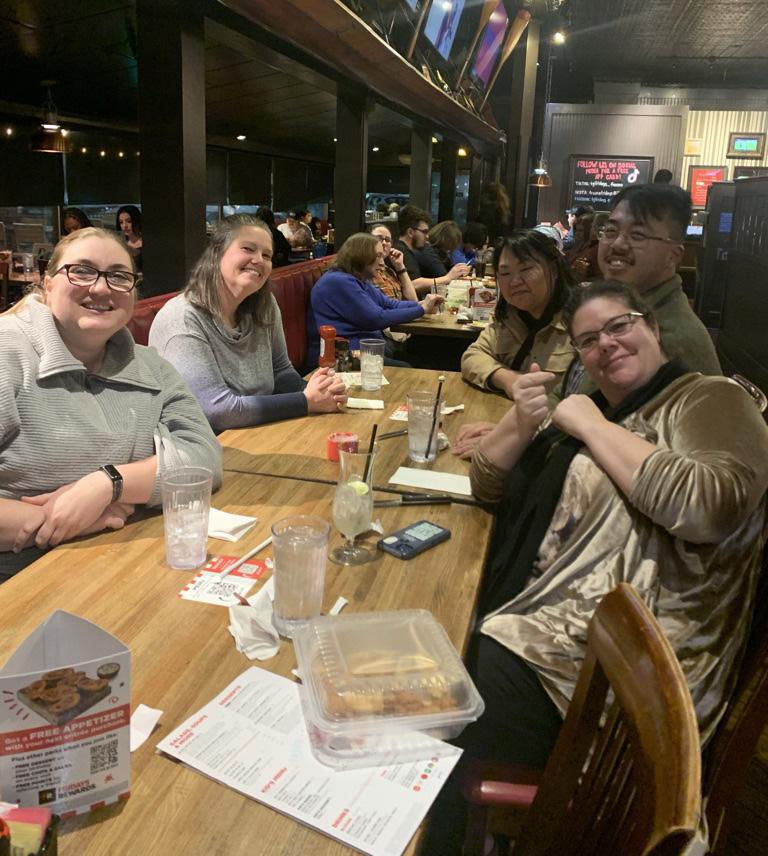
• Come with an open mind. Some of the sessions might present information or knowledge that can challenge your way of thinking, learning, and teaching!
Also during CASMEC, the team of music educators at Monroe High School in North Hills (Ryan Gonzales, Kristin Staves, Martin McSweeney and Cristal Morales Rodriguez) connected with past CMEA president Mike Stone to draw upon his help to develop a strategic arts plan. Two weeks after the conference, the result was a finely-tuned comprehensive plan that will benefit the Monroe Community of Schools’ students for generations to come.
This year’s CASMEC was a time of great discussions with Prop 28 being a prominent topic and a showcase of truly remarkable in-person performances by our students in the honor ensembles. I truly hope to see everyone again and to meet more of our great colleagues throughout the state at next year’s CASMEC!
Spring Issue 2023 17
Choruses & Conductorsthis summer is your time to
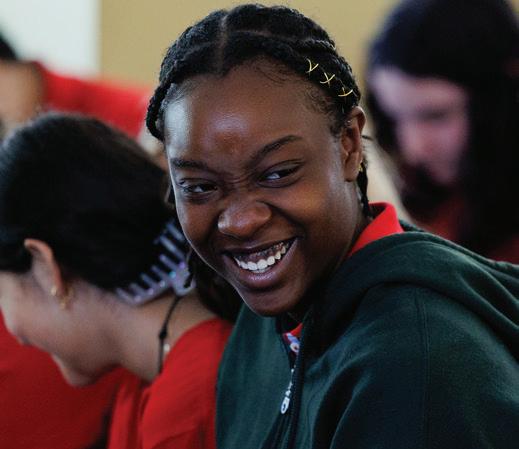

SHINE
A once-in-a-lifetime learning experience to join renowned conductor and composer Francisco J. Núñez and the Young People’s Chorus of New York City for YPC National Studio and Lab in residence at Music Academy of the West in Santa Barbara, CA.
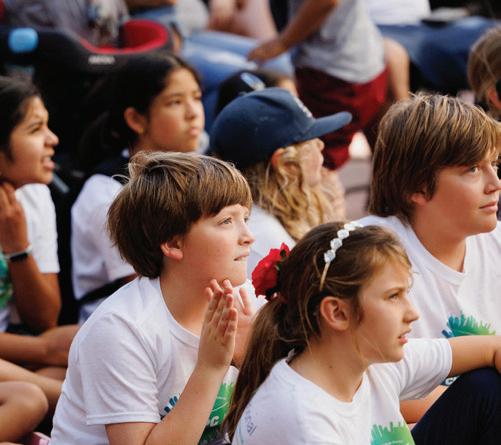
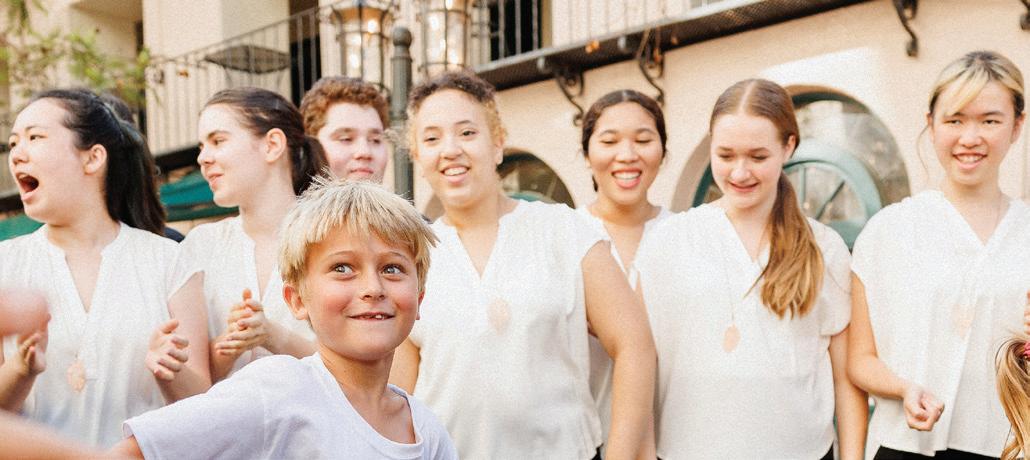



JULY YPC NATIONAL STUDIO AND LAB SANTA BARBARA, CA 18-23, 2023 ypcnational ypcnational For more information, visit ypcnational.org
Bay Section Update
Sandra Lewis Bay Section President

Greetings From Bay Section!
Capitol Section Update
Patrick Neff
Capitol Section President
For our Spring issue, I had the opportunity to speak with Samuel Elmore, a new music educator in our section and recent graduate from Sacramento State’s music education and credentialing program. He is a colleague in my district, and I was excited to speak with him after seeing the great work he has done already. Here is our conversation:


Please tell us about yourself.
I come from a large family of musicians and while it was always clear that it was not being pressured on us kids, 4 of my 5 siblings are musicians. It was pretty cool growing up in a family of musicians, and it is even cooler to be one of three “Mr. Elmores” who are teaching music in Northern California. I started playing trumpet at Joseph Kerr Middle School with Nancy Kreis in 7th and 8th grade, and I continued into Elk Grove High School with Mario Sebastian. After high school, my life departed onto a different route, but I continued my playing through the Sac State Marching band for 3 years and the Sacramento Mandarins Drum and Bugle Corps for four years. By the end of my fourth year of college, I came back to music at CSU Sacramento and graduated there with my Bachelor of Music Education and my Single-Subject Teaching Credential.
Please tell us about your current position.
Before my credential, I made my living teaching after-school marching band and elementary school music programs, and I am now the band director at Oakmont High School in Roseville, CA. I teach Marching Band, Symphonic Band, and four sections of Guitar. I will also be returning to Casper, Wyoming, for my third season as a trumpet instructor for the Casper Troopers Drum and Bugle Corps.
What have been the best aspects of your first year of teaching?

If I could sum up this job with the best aspects, I would say that it is the relationship building and the observation of student growth. Watching my students grow from just the start of the year to now has been truly humbling. Musical growth is my hope and expectation for these students, but watching their social development, development as leaders, and their confidence increase has been incredibly rewarding. Music directors are in a very privileged position to get to understand their students on possibly a deeper level than other subjects. Coming into this job, I really

Spring Issue 2023 19
thought that building relationships were meant for building trust when it comes to musical direction and having a “place” on campus, but this year I have realized that it is also about developing a culture where students feel comfortable sharing even the most challenging or traumatizing parts of their life, past or current. It is about building a band that the students are comfortable showing their director and their peers themselves at their happiest, their saddest, and their angriest, their weakest, and their strongest. It is a culture of vulnerability, trust, and confidence that we are trying to build that allows us to have difficult conversations and teach difficult lessons. It gives students a safe space to come to us with information that they know needs to be reported, but they do it anyway because they trust that we will walk them through what is best for them. I could elaborate on this in much greater detail, but the bottom line is that the best aspect of teaching music so far is that the relationships we are building and the growth we are nourishing will always come first to the music, and that has taught me a great deal of humility and understanding that I might not have considered a few years ago.
What are some challenges, and how have you approached them?
What I mentioned above is a challenge at times. Students have come to me with very difficult situations that sometimes resonate with me deeper than just wanting what is best and that can be challenging, but I would like to believe that it is most of our nature to toggle certain parts of our emotional response to ensure the safety and well-being of our students. I have approached these situations with a clear sense of priority for my students. One instance had me calling a sub for a half day just to be with a student and walk them over to our wellness center and have a difficult conversation with their counselor, parents, social workers, police, and other entities that are very scary for a child. When they pick you, it can be tempting for some to prioritize the lesson and the classroom. I think we are in a world right now where if they pick you, then you have a unique opportunity to be their champion and their role model in a way that goes far beyond the realm of music. It is my belief that this should be your immediate priority. None of the successes that I have mentioned are to praise me or to claim that I have a precise handle on teaching because I absolutely do not, but what I have learned is that these are very real parts of the job that are challenging and require us to think, often with precedence over our lesson plan. This challenge of the job goes hand-in-hand with what I think are the best aspects, which is why I have put so much urgency into this part of the job. I have had PLENTY of other challenges, but I wanted to highlight this one because these are not situations that we can perfectly plan for and oftentimes do not necessarily think about until they are happening.
How was your experience at CASMEC as a first-year teacher?
I want to talk about my CASMEC experience before and after I started teaching, because it highlights my experience this year. My first year attending CASMEC was before I had received my credential and while it was full of good information, it was honestly a bit overwhelming at times. Before teaching, our credential program and our student teaching gives us a lot of preemptive knowledge that we know we will eventually need to know, but
we do not know exactly when or how we will use it. Going to CASMEC that first year felt like just more information that I was going to love and appreciate and clap for and then hope and pray I remember it for when I become a teacher. Moving forward to this year, everything was viewed in a different lens. I could select lessons and seminars based on what I was needing in my classroom. I could create a focus for the day and extract information that pertained to my situations at school and a lot of it was information that I could use on my very first day back, which was invaluable. I think that it is still important to attend a convention prior to receiving your credential and begin networking and informing yourself on parts of the job. I will say also that this year was more focused and impactful for me now that I can readily utilize the information presented.
What advice do you have for music educators entering the field?
For new educators coming into the field, first and foremost would be to remember that the students come before the music, as I mentioned before. Apart from that, I would say figure out your identity as a teacher and go with that. Do not try to be your cooperating teacher or your middle school band director or your private instructor. Take what you can from all those people and apply it to your own identity. Not only is it unsustainable to be someone that you are not for 30+ years, it will burn you out and it will take a long time for you to feel comfortable in your classroom. I will also say that you should not ever feel like you are too young or inexperienced to advocate for your program. This does not mean you should go challenge your administration, but it does mean that you are the expert and you should set a precedent wherever you are that you are going to be someone that cares and advocates for your program. The students see that, the parents see that, and your site will see that and move forward with that understanding of you. Do not bite off more than you can chew, but definitely recognize that depending on your site, you may have to champion your program more than other directors. I would also say that it is important during these conversations that just because you do not feel supported does not mean you need to approach each entity as unsupportive. This can cause a lot of discord and strife and unwillingness to work with you in the future. Instead, it is our job to educate our school and our district how we need to be supported and what that means for our unique situation. Proposition 28 is going to be great for so many programs, and maybe you find yourself in a program where financial support is not really an issue. Support might also mean asking your administration to come to shows and competitions to see what your students do and show them the value of your program and the investment it is having with these kids. Figure out what you need early on and start advocating and working WITH your administration to make it happen.
Is there anything else you would like to share?
I would just like to thank CMEA for this platform to share a little bit about my first year and I hope that it can be helpful to other directors out there! We all need to learn from each other and whether we are a first year or a 35th year teacher, we all have something fresh to offer. I am glad that I have the opportunity to share my own perspective and ideas with the community and I wish everybody luck and skill as they close the last few months of the school year!
20 CMEA Magazine
Central Section Update
 Michael Tackett Central Section President
Michael Tackett Central Section President
Throughout March and some of April and May, the Central Section is always busy with hosting festivals. This year was no different! We had seventeen large ensemble festivals and three solo and ensemble festivals. The large ensemble festival registration numbers exceeded expectations. We were thrilled to have so many schools involved. For the first time, all festival sites offered a sight reading portion.
The Central Section Board starts the process and makes certain logistical decisions about the festivals, but the real heroes are the site hosts and our festival coordinator. Each site host spends countless hours preparing and running their festival. We are honored to have such dedicated and talented teachers who offer their time and resources to make these festivals a great experience for the students. I would like to give a huge shoutout to the following hosts for their dedication to our festivals.
Clarke Keele – Porterville HS
Mike Schofield - Kingsburg HS
Daniel Paulsen - Reedley HS
Brad Pickett - Independence HS
Ben Horton – Actis MS
Geoffrey Ruud - Stockdale HS
Amanda Sproul – Stockdale HS
Robert Madrid - Washington Union HS
Amanda Isaac - Bakersfield HS
Josh Sutherland - Porterville HS
Donna Steigleder – Summit Collegiate HS
Jennifer McGill - Hanford HS
Randy Berger – Retired, Bullard Talent
Carly Ervin - Sierra HS
Tony Mowrer - Fresno State
Regina Montano - East Bakersfield HS
Scott Dirkse – Bakersfield College

Lisa Fritz – Sequoia Youth Symphony
Mario Capote - Tulare Union HS
Beverly Moorhead - Fresno HS
Wendy Shrestha – Sunnyside HS
Chris Morshead – Liberty MS
Rob Bentley – Liberty MS
Elisha Wells – Fresno City College
Hannah Lambert – Ridgeview MS
Serving your local or state music association is vital for organizations to survive and be successful. If you have the desire to help in any way, please do not hesitate to contact someone affiliated with the Central Section. We would love to work with you in any capacity you feel fit. We are blessed to have hard working, loving and caring educators in the Central Valley. Get involved, meet new people, and serve. You will not regret it!
Spring Issue 2023 21
Central Coast Section Update
 Sam Oh
Sam Oh
Central Coast Section President
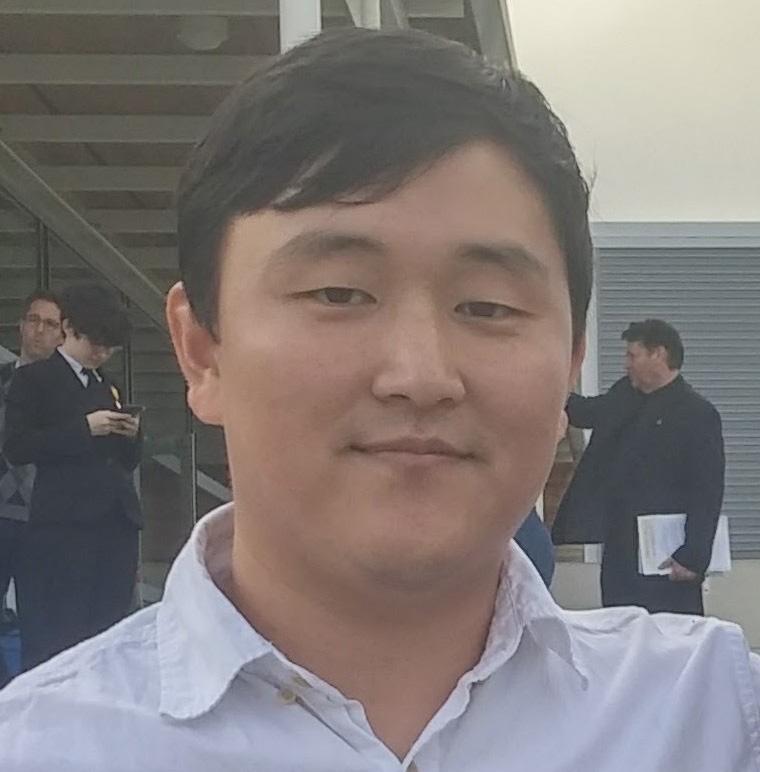
Around this time of year, we are busy getting ready for our YES! Showcase, Instrumental, Chorale and Solo/Ensemble Festival. So far, we only had the YES! Showcase festival. I could not attend in person because I was in the hospital for the birth of my first baby daughter, but I was told it was a huge success and all the elementary and middle school students had a lot of fun this year. As for the other festivals, due to the crazy storms and Mother Nature destruction in Monterey county, San Benito and Santa Cruz county, we have to cancel our original dates. We are in the process of changing the dates to a different weekend.
Our honor events went very well and it was great to see a live audience to watch the performances. The atmosphere and the experience cannot be replicated through a virtual performance. Just hearing applause and cheers was awesome for the students to be acknowledged for their hard work and dedication.
After the high school band and orchestra honor event, the orchestra guest conductor and I began discussing the lack of string programs within our section. The orchestra conductor also leads and

conducts Youth Orchestra Salinas (YOSAL), which is an afterschool El Sistema program. Their purpose is to serve the underserved community by offering free music programs and lessons. We discussed how there is a real need for my string players and talked about how his program can help jump-start string programs into the schools.
With the grant from the state and Prop 28, we hope we can start pushing schools and districts to open the doors to allow string programs to flourish in good faith to help build a stronger community between all the programs and help grow the string program. This summer, YOSAL will host their 2nd year of California Orchestra Academy on July 5-15. Last year, they had around 60 students from around the world to participate and their goal this year is to have more Central Coast students to participate. Students from underserved communities, or El Sistema or El Sistema-like programs, get a full ride, including room and board.
22 CMEA Magazine
North Coast Section Update

Collin Kirkwood
North
 Coast Section President
Coast Section President
Hello from North Coast!
Our section had a strong representation at this year’s CASMEC, which was impressive because it is a journey to get to Fresno from the North Coast. We also were very excited that Cassandra Moulton-Rizzo received the Educator of the Year from our Chapter. Cassie is a very hardworking teacher and while any of our members could have easily received this award, it was nice to recognize Cassie.
We have all been working hard to get festivals up and running. Our largest festival, the All County Music Festival, took place March 17th & 18th. So many of our teachers participate in this event. A few local teachers (Jared Coyle, Holly MacDonell, and Lisa Jouaneh) directed the three junior groups (band, strings, and choir); Dr. Elisabeth Harrington from Cal Poly Humboldt directed the Senior Choir; Les Nunes conducted the Jazz Ensemble; Dr. Christine Lundahl conducted the Senior Band; and Tiffany OuPonticelli conducted the Senior Orchestra. Thanks to the support of the Humboldt County Office of Education (HCOE), we are able to invite such accomplished, out-of-county music directors to lead and inspire our North Coast students.
Local teachers also help coordinate the groups, move equipment, lead sectionals, even perform in the event of a missing bass trombone or baritone. This event is an awesome experience for our students as this is the only honor ensemble many of them will get to be a part of.
One of the brightest moments of this year’s festival was the opportunity for all seven groups to perform in Eureka’s Arkley Center for the Performing Arts. We appreciate the cooperation and continued support of the Humboldt County Office of Education each year we have this event, and specifically Michael DaviesHughes, Humboldt County Superintendent of Schools, who was instrumental in getting this year’s groups out of a high school gym and into a professional performing venue.
Another bright spot of the festival was the return of the Junior performing groups, who last performed in 2019.
With a wrap on this year’s All County Music Festival, we look ahead to our Instrumental, Choral, Jazz, and Pan festivals later this Spring!
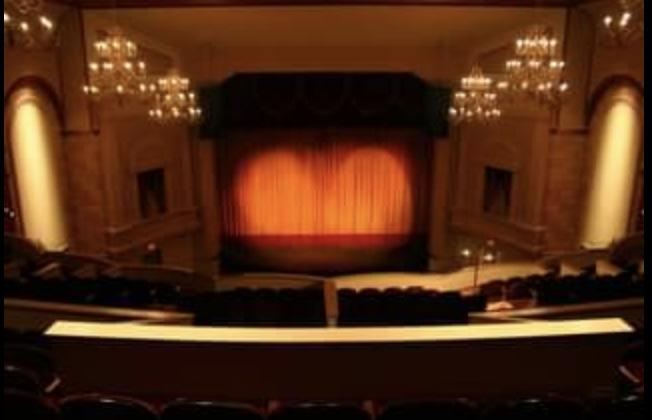
Spring Issue 2023 23
(the Arkley Center for the Performing Arts)
Northern Section Update
Tanner Johns Northern Section President
Jim Norman’s musical studies began at age eleven when he joined the “Weldonians” marching band and was introduced to band music and rudimental style drumming. Jim attended public schools in Oakland, CA, continuing to play in concert bands, jazz bands and weekend bands until graduating from Cal State Hayward in 1976 with a major in percussion performance and music education. The following fall began what was to become a teaching career which has spanned four plus decades in the community of Greenville in Plumas County, CA, teaching instrumental, vocal and general music in grades K through twelve, as well as math, art, P.E., and business and finance.
Jim has been active in CMEA having served as coordinator for the Northern California Junior High Honor Band and Select Choir, as well as hosting and coordinating numerous regional festivals and honor bands.

Jim has guest conducted several honor bands, and has received the California Music Educators Association Northern California Outstanding Music Educator award, and Plumas Unified Teacher of the Year.
In retirement, Jim continues to compose and arrange for band, jazz band, and orchestra, and stays fairly busy doing instrument repair and maintenance for Plumas Unified Schools, as well as shop projects, daily walks and bike rides, photography and reading.
Jim and his wife Gina live in their 100+ year old house in Taylorsville. They have two grown daughters who both attended GHS and played in the Greenville Band, and have since graduated from college and are living in the Bay Area. He and Gina enjoy camping at Lassen Park, vegetable gardening, and fly fishing on Hat Creek as well as other undisclosed locations.
What is your idea of advocacy?
Advocacy is about building relationships with students, parents, community, and (perhaps most importantly) colleagues. This is especially true in a small school setting, where those of us who teach elective classes depend on enrollment, which can be detrimentally affected by any number of factors, including: scheduling conflicts, graduation requirements, remediation classes, as well as other elective programs competing for the same students.
Why is it important for the arts and music?
Beyond the obvious exposure provided by public performances and exhibits, advocacy is important for arts and music because successful programs have continuity, allowing the inclusion of different grade levels and experience levels, which leads to
collaboration between students through role modeling and social interaction, facilitating a strong connection between fine arts education with value judgements and life skills.
Have your ideas about advocacy changed over the course of your career? How?

When I started teaching at GHS in 1976, I was the staff youngster in a field of OLD PROS, and really had no idea of how to build a program, and advocacy became overshadowed by survival. After a few rough years, I started to settle in and set my ego aside, and began to see the bigger picture, and realized that the process involves establishing those relationships not only with students, but with teachers, administrators, and (in our case) the counselor, because the counselor wrote the master schedule.
Over time student advocacy gained importance as they became faced with increasing graduation requirements (including lengthening the school year), increased rigor in core classes oftentimes brought on by (flawed) federal legislation to teach to the “standards,” and the competitive nature of qualifying for and being accepted into college. For example, on more that one occasion I had students opt to take a year off from band so that they could take a second science class, because it would “look good” on their transcripts.
How does advocacy for music differ for rural communities than it might for other areas?
Rural school districts are oftentimes in a unique situation. For example, Plumas Unified has four distinct and autonomous communities, each being their own attendance area, spread over 1.2 million acres, with the total number of students district wide (for this example grades 9-12) still being less than enrollment of one large urban high school, yet we have four of everything: campuses, principals, teaching staffs, transportation routes, band directors, athletic coaches, food service facilities, custodial staffs and so on…..
That said, there are a lot of expenses, and money is always an issue. Perhaps the strongest advocacy force in our district has been parents, and we all know that board members and administrators will listen to parents. Parents want their schools to offer opportunities for their kids, and when their kids come home from school excited about what they did in band that day, or that they had a good practice in extracurricular athletics, it registers with parents because they want their kids to be happy, and they express that through supporting what’s going on in their schools.
How might they be the same?
Parents will have similar values regardless of school size, however, larger schools by nature encourage specialization. For instance, one of my former students from GHS moved to San Jose and attended high school there for one year. She enrolled in band, and had to work really hard to keep up, and was one of the very few students in the band who did not have a private teacher. As a result, parents, like students, become more specialized, unlike in rural schools where it’s not uncommon for parents to advocate for their students who are on the honor roll, play two or three sports, play in band, and are active in student government.
24 CMEA Magazine
Sometimes, being an advocate means being proactive. One year, our principal approached me and two other teachers and told us that he was buried, and could we draft a master schedule for the following year. We agreed, and met after school in a classroom and talked for a bit to understand the scope of the project, then began to sketch it out on the whiteboard, revising as we went. The following week the principal presented it to the faculty for comments. After running several students’ names through on a “dry run,” a few adjustments were made and it was adopted.
The two colleagues with whom I worked taught (primarily) math and science, and our interaction helped me understand the student placement process in math and science courses, and it helped them to understand the fragility of music programs based on scheduling. After that, it became fairly commonplace for faculty members to help design the schedule, which in turn benefitted all of our classes and programs.
What role do the arts and music play in the communities of rural California? In your opinion, why are they so important to these communities?
Arts and music, along with academics, athletics, and school climate, all contribute to the culture of these rural communities. In many cases, the school is the main hub of the community, and the school activities – back to school night, homecomings, music and drama performances, art exhibits, senior project presentations, science fair, and home athletic events – are a big draw and are well attended by parents and community members alike, as a show of support and appreciation for the local school.
How do you think the music program in your school was considered important enough to keep through budget cuts, natural disasters, and so much more?
One challenge with budget cuts is parity. If something is cut in one community and not in another, there will likely be some angry parents. Plumas Unified has (for the most part) really stood by music education, especially since the first big budget crisis in the early 80’s when our superintendent intervened to prevent scheduled layoffs of music teachers by providing funding through the Plumas County Office of Education to expand elementary music programs to include classroom music for all grades, in addition to chorus and band for the intermediate grades. This step made a huge difference in establishing music as a part of each student’s curriculum beginning in Kindergarten, it strengthened the importance of music in school, and was appreciated by the parents. Establishing a K-12 music curriculum throughout the district was perhaps THE important step in protecting music education from pending and future budget cuts.
Since then, support has been fairly consistent, although most recently the effects of COVID and the destructive Dixie fire have
taken their toll, not just on music programs, but on all aspects of education, as well as local economies and community culture, to the extent that everyone is playing catch-up, and rebuilding in one way or another.
Consistency: I was committed to GHS. My family lives in the community, we shop here, our kids were raised here, my wife worked here – I guess you could say they were stuck with me, so I had to figure out how to make the kids want to take band, because I was pretty sure it would never be a graduation requirement, thankfully so.
This led me to constantly re-examine what I was doing in the classroom, to be my own critic, to listen to the wisdom of my wife when I would come home and want to quit because of junior high kids, or after the band got dinged at festival for playing music that was too hard.
Accessibility: I had one principal who really had an impact on my teaching, because his mantra was “EVERY STUDENT SUCCEEDS.”
While this sentiment was not readily embraced by several of my colleagues in the core classes, I took it to heart and began to look at teaching differently, not so much from the authoritarian conductor standpoint, but from the “how do I make sure that everyone in band, from the hot first trumpet player, to the 3rd clarinet quiet kid is having a quality experience?”
Tradition: Kids like tradition, they like knowing what to expect, they also like bringing the younger kids into the group and letting them know that “we did this last year, and it was fun.” The teacher challenge in this is being able to think outside the box without destroying the box.
Closing thought
The spectrum of advocacy can cover a broad range, from submitting a short blurb to the school’s weekly newsletter, to confronting the school board over budget cuts and/or layoffs. Music is something about which we all share a common passion and is a big part of our lives both in and out of the classroom; but for our students, music is one component of their educational experience, and we owe it to them to recognize that, and to make every effort not only to do the best job that we can as music teachers, but also, to help them maintain a balance between music, academics, extracurriculars, as well as family and personal needs.
Spring Issue 2023 25
What’s an example of a way you advocated for the arts and music that’s maybe less traditional than what people might think of as advocacy?
Despite Greenville’s declining population over decades, your music program continued to thrive. How did you help make that a reality for your community and how did you make yourself and your program so indispensable?
Southeastern Section Update
 Dr. David Betancourt Southeastern Section President
Dr. David Betancourt Southeastern Section President
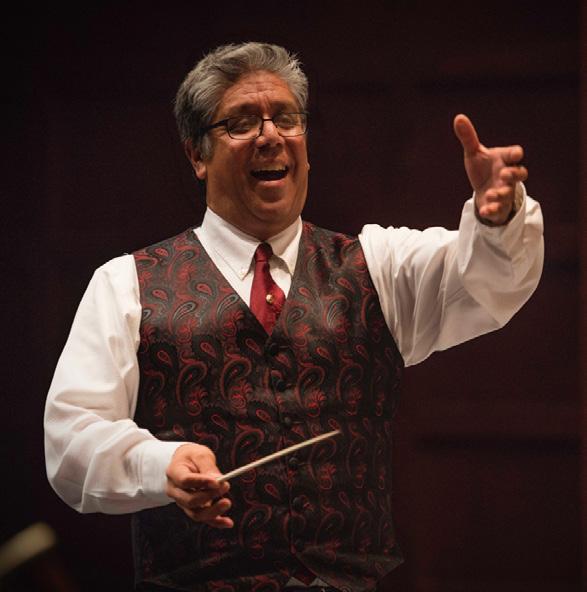
The CASMEC Conference was such a great experience. It always is. But this year, being back to full tilt, it felt like something special. I spent the time reconnecting, meeting new colleagues, making new friends, and learning. And the stories. So many stories. Here is just one that happened at CASMEC this year.
We make a difference. Small acts can have a huge impact.
While at the conference, I took some time to clinic the band at a local high school. Hoover High School is a Title I school that has an allotted annual total budget of $1,200 for its band and orchestra program. That is not a typo. That amount must be used for all needs. But let’s not focus on that for now. I would rather focus on the amazing work that Stella Perez is doing with her students. She is making a difference and it shows. During my visit, respect, teamwork, sense of community, and love of music were on full display. It was wonderful to experience and to share in music making with them.
Halfway through the rehearsal we ran into a musical challenge in the snare part. It was then that I noticed the snare drummer was extending her arms fully in order to play the snare. I tried to help by suggesting that the snare be raised. She looked at her director. The director looked at me. It all came crashing into my head. The snare stand was broken. Not only that, it was the only snare stand. I felt foolish for a second as I realized I had just underscored the lack of equipment. I turned it into a teachable moment and asked the entire band to come up with a solution that will allow us to raise the entire stand up about a foot. They made some on-the-spot suggestions. I left it as homework for them. The clinic ended and I went on my merry way.
But that incident stayed with me. I was thinking what could be done. As it happens, the next evening I found myself at a small table (at the bar) with Jeff Queen (Yamaha), Anne Fennell (CMEA President), and Marcia Neel (Music Educator Icon). I shared my story and then asked Jeff if he had any extra snare stands to donate. He did not, but he got on the phone on the spot and contacted the local music store. After sharing the story with the folks at Gottchalk Music Center, he secured a snare stand that they would bring the following morning to the vendor area for us to purchase. No sooner had he gotten off the phone that Marcia exclaimed, “Nobody is buying that snare stand! I am buying it!” Wow! It had all come together. I was inspired by these acts of kindness and asked Anne how we could get this story to our colleagues. She chimed in that inclusion in the next CMEA publication would be the perfect place.
And now that snare stand has found a home. The snare player at Hoover High School can be taught correct technique. Not only that, but the band will sound better. And if that is not enough, the impact of that donation will not just be felt in the moment they received it, or the subsequent rehearsals this year, but in the following years as well, with all the students who pass through Mrs. Perez’ music program.

We make a difference. Small acts can have a huge impact.
I am so proud to know all the individuals mentioned in this article and to be part of an organization that cares so much about the people around them.
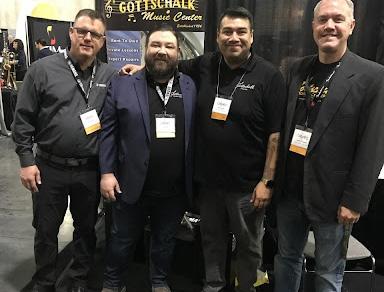
26 CMEA Magazine
Southern Border Section Update

Dr. Jeffrey Malecki
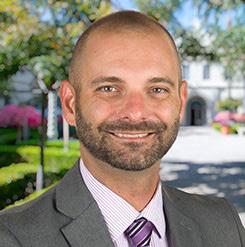
Southern Border Section President
Things are great at the bottom of the state!
And as far as the CMEA Southeastern Section activities? Well, we recently had an amazing inaugural leadership symposium for high school students that is sure to grow in popularity and reputation as we expand our reach to provide our area with services and resources. The section is also holding its first ever Mariachi Showcase. It will be an amazing event highlighting what our region is doing in the field of Mariachi music education. The event takes place May 6 in Anaheim. This non-rating, non-adjudicated event will focus on stellar performances and clinics with two of the profession's top educators and performers: Cindy Shea (CEO and founder of Mariachi Divas, and Cynthia Flores (Professor and director of Mariachi of CSULA).

Spring Issue 2023 27
Southwestern Section Update
Dr. Tamara Thies Southwestern Section President
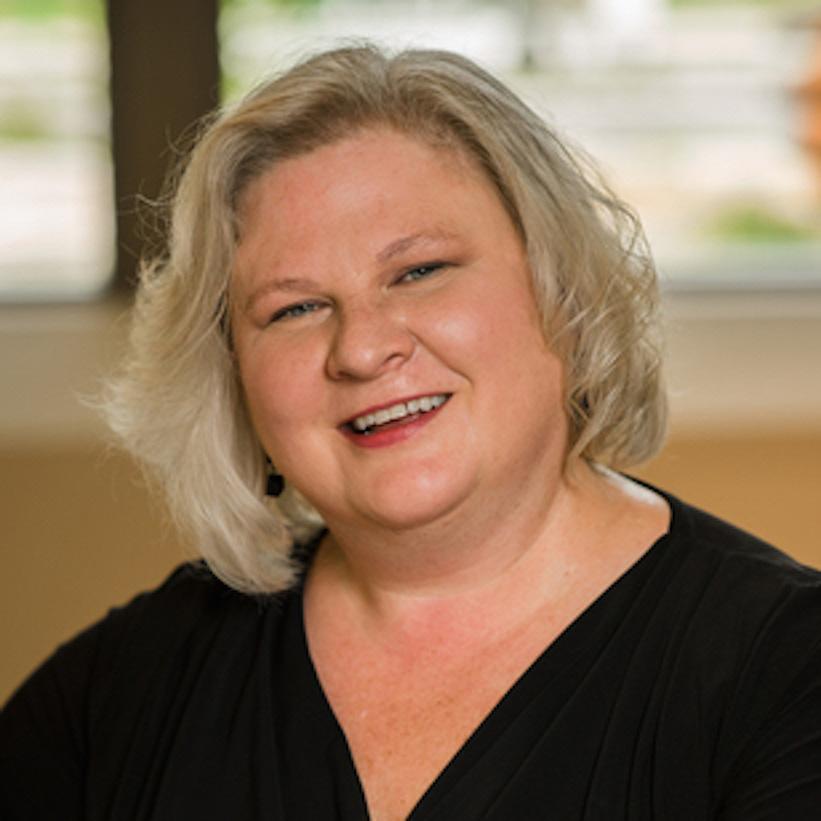
As the curtain falls on the 2023 California All-State Music Education Conference, many ideas surfaced that offered new insights, reinforced established practices, and possibly even challenged our own perspectives and approaches to our personal teaching styles and philosophies. Many California music teachers are designing and implementing strategies, curriculum, and experiences that are guided by their own students’ backgrounds and knowledge. For this reason, this edition of the Southwestern Section report will spotlight a perceptive, responsive, and forward-thinking young music educator, Dennis Feinland, and his approach to beginning a new songwriting/music production course for his students at Cabrillo High School in the Long Beach Unified School District.
Dennis Feinland is a second-year music teacher who teaches three guitar classes, band, marching band, and an introduction to songwriting course. Cabrillo High School is a Title I school serving 2,007 students (grades 9-12) who reflect a minority enrollment of 99% with 80% of the students considered economically disadvantaged. Like most beginning music teachers, Dennis spent his first year getting to know the students and how best to approach student learning needs in the differing music classes of guitar, band and marching band. As he adapted to the needs of his students, he realized that he wanted to open some opportunities for his students that often are not implemented in Title I schools. He learned about a grant within his district, applied for monies to build a portable Mac lab, and acquired the funds to purchase equipment needed for this technology-based course. Additionally, the district already approved an Introduction to Songwriting course in the past, so he was set to immediately begin teaching this new course at Cabrillo in the Fall of 2022—his second year of teaching. The response to the program and the musical productivity of the students indicate that Cabrillo’s new songwriting/music production course is a positive fit for the students in this music program.
The following interview has been reproduced to offer insights into how the songwriting course at Cabrillo began, note challenges and solutions, and offer benefits to the students and community.
Why begin a songwriting/music production program?
The number of students attending Cabrillo had been decreasing in the school as well as the music program. This prompted me to question why we are offering classes that do not appeal to the students. The songwriting class provides an opportunity for students who like music but have no interest in playing a clarinet, trumpet, or guitar. I saw this as a way to get more students into music.
There was also a personal bias involved. One of my mentors once told me to “create a job that you’re excited to wake up for.” I enjoy playing the guitar and writing songs, so creating a course around this idea appealed to me. Additionally, I like to do things that others are not doing. Even as I was growing up, I wanted to play every instrument or try a new way to make music. I enjoy developing and creating, so I was excited to try this course with our students.
What did you need to set up the program?

I just happened to be in the right place at the right time to learn about a grant that brought over $90,000 to our music department. A portion of this money was used to purchase a mobile MacBook lab. We purchased 40 MacBooks, 40 headphones, a couple of audio interfaces, 5 MIDI keyboards, a couple of microphones, and Logic Pro licenses for each MacBook. The primary reason we purchased Logic Pro was because I was most familiar with this software so I could guide students more easily through the production of their music.
In addition to the money, I provided a justification for the administration highlighting the interdisciplinary nature of the course, how the course could access more students, as well as guide students to use current industry technology. Because the district already developed a songwriting course that was available to implement in any of the Long Beach schools, I did not need to recreate the standard course outline.
We also needed a physical space. Coincidentally, a teacher next to the music room was transferred so that opened a space for the class next to the music area.
Finally, I needed students. Administration required I attract a particular number of students to offer the course in the fall semester. I talked with the ASB teacher to advertise the course frequently in the school announcements as well as put up posters and talked with students. By the time school started in the fall, I had too many students for the physical space and actually had to turn away three students. (I did tell those three students that they would be first on the list for next year, however.) Everything had fallen into place, and our first class met in the Fall 2022 semester.
What challenges have you faced?
The primary challenge has been teaching the class…deciding what to teach and how to present the information, as well as assess student growth. While college programs open many opportunities to teach students in band, orchestra, and choir, there are not many programs that teach songwriting or music production so undergraduates can practice this very different style of teaching.
I remind students, a lot, that I haven’t taught this class before and appreciate their patience. We have some weird and confusing days, but we are learning together and the students are very accepting within this collaborative community.
Every lesson I start with a finished product for the students to hear. I model a lot of the information in different ways. If students have prior knowledge, I will throw things together in the moment; whereas, we will do things together, step-by-step, if there are new technological functions they are implementing. There are times when something goes wrong and I can’t figure it out quickly, so one of the more advanced students will step up and show everyone. If a student is struggling, I will ask them to check out their neighbor’s
28 CMEA Magazine
computer and often the issue is remedied. Finally, I use a lot of repetition throughout the classes. As I’m figuring out how to sequence the information, teach, and assess, I find that I often have to go back and reteach.
What might someone expect if they would like to start a songwriting/music production program?
Students bring a lot of themselves into the class. They are making music that they like. Students expect you to bring yourself into the class. Share your own music with students. Share successes and mistakes. Be willing to make mistakes.
Get comfortable with being uncomfortable and not knowing what is going on. You will learn as you go and adapt on the fly every day. There is a lot of second guessing after the fact through reflection. You will likely feel like a first-year teacher, again.
There are different kinds of barriers for student success. Some students had never used a MacBook before, so they did not necessarily know how to turn the computer on. You will be teaching technological literacy, so be prepared to be staring at screens a lot.
Students have differing levels of competency. Some are more advanced than the instructor. For example, I was teaching quantizing and was getting frustrated because the beats would not align; a student pointed to the “flex and follow” box which assisted me to show students in the moment. Some students struggle, some sound professional, and most fall somewhere in the middle. Because of this, allow students to work at their own pace and be open to differing levels of assessments for student submissions. For some students, creating four measures is enough; whereas other students will elaborate significantly for the same assigned four measures. This course is about the process and not necessarily the perfect product.
Prepare for administrative questions especially around cost effectiveness. While the majority of your colleagues (teachers and administrators) will be positively supportive, expect some push back from some colleagues who may not understand why these kinds of classes are important for students.
Finally, expect to have fun! Students will notice that you are a different kind of teacher in this setting and will appreciate this approach to teaching. I know these students really well because they share a part of themselves every day they come into class.
What are some benefits related to your songwriting/music production course?
Students attending Cabrillo High School often struggle to attend classes, let alone turn in homework, which leads to a lower graduation rate. However, students in the songwriting class attend class regularly and rarely miss a deadline for homework. In my mind, there are several contributing factors for this success.
There is a great sense of pride within the students because they know that they are only one of two schools offering the songwriting course in the district. When they learned that their school was the only mobile Mac lab in the district, it made them feel special. This assists with their mindsets.
The act of songwriting itself is a more intimate process. The subject matter requires us to bring in our personal music tastes to the table. I can get a picture of who the students are; therefore, I feel I really know these students in a different way.
Finally, I am forced to limit what is achievable during class time. I can’t really assign much homework because students don’t have access to MacBooks or Logic outside of class. Homework assignments might include listening, but work must be completed during class time. Subsequently, students never feel like they can’t show up to class because they haven’t finished their homework. This alleviates a stress students carry.
Rewriting the Title I Stigma
Students in Title I schools are aware of how they are categorized and perceived. This can lead to a sense of low self-esteem, a fear of failure, and/or a fear of embarrassment. Songwriting and music production courses offer easier entrance points for high school students who may or may not have prior musical knowledge. This form of music making is more accessible to students, and it builds student identities while developing musical skills. Songwriting shows students that we can all create music.
Spring Issue 2023 29
Rentals Lessons NICKRAILMUSIC.COM . 800-649-5354 AGOURA HILLS REDLANDS SANTA BARBARA BAKERSFIELD VALENCIA CAMARILLO
CMEA Collegiate Council - CASMEC Update
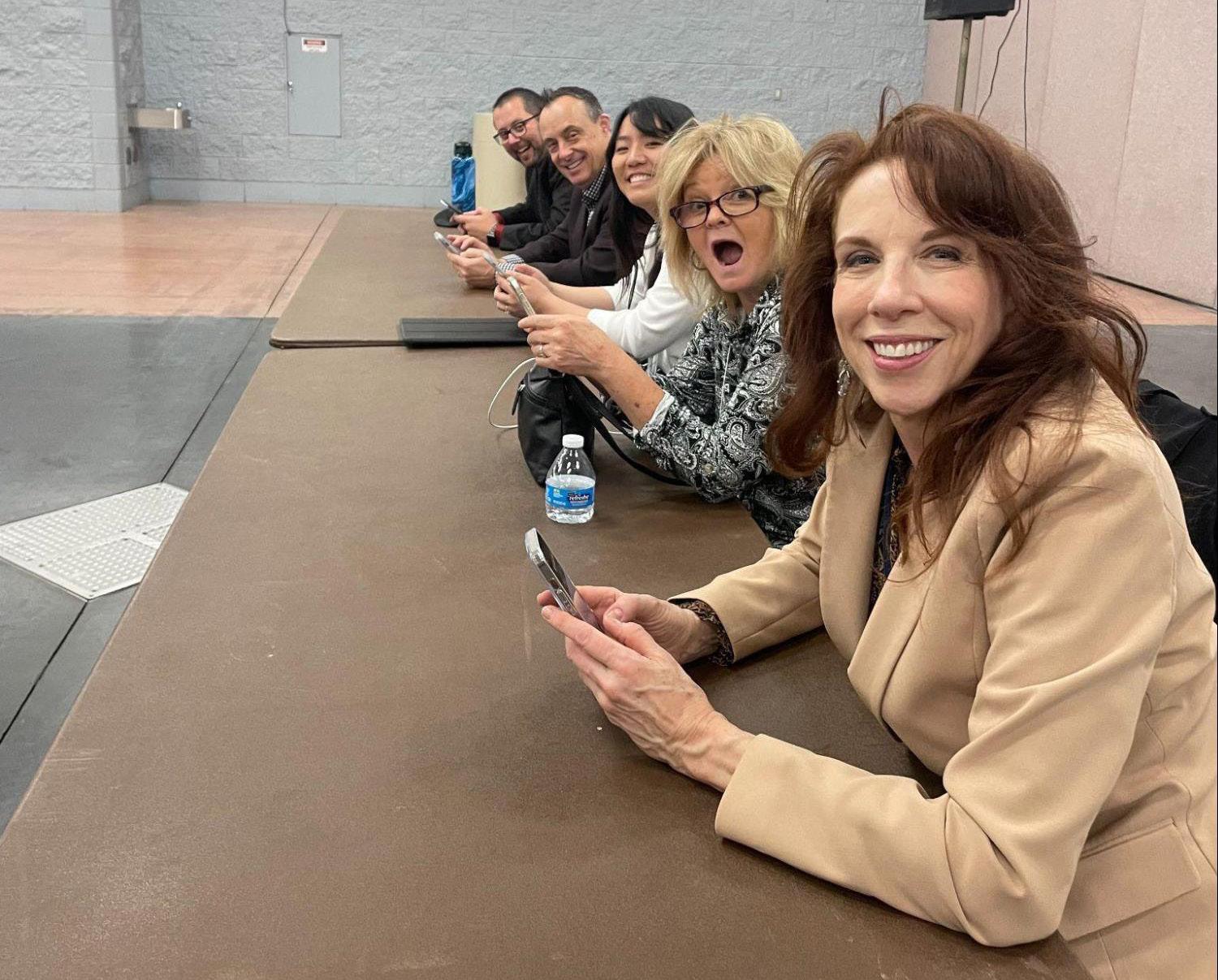 by Daniel Crispino, Caitlin Cooper, & Victoria Guerrero
by Daniel Crispino, Caitlin Cooper, & Victoria Guerrero
CMEA Collegiate Council
CSAMEC Update - Thank You!
Thank you so much to everyone who came to our collegiate sessions during CASMEC! It was awesome to have everyone together and get to hear as well as learn from our presidents. We had a wonderful time getting to know everyone and learning how we can support you as collegiate students!
Who Are We?
The CMEA Collegiate Council is a body of collegiate music education students from across the state of California. Members of the council are prominent leaders in their respective school NAfME chapters and CMEA sections. In addition to creating more collegiate opportunities and resources at the annual CASMEC Conference in February, the Council represents collegiate interests at the state and national advocacy events and fosters a dialogue between music education students throughout California.

Collegiate Council Interest Form:
If you are interested in being on the collegiate council for the 2023-2024 school year please, fill out this form. Even if you are on the verge of whether or not to join, fill it out and we can provide more information about it. We would love to have more representation across the state and more colleagues to work with so that we can build stronger collegiate support. It’s a great experience to learn about advocacy, build connections with other music educators around the state, professional development, and so much more.
30 CMEA Magazine
California Alliance for Jazz Collegiate Chapter

The new California Alliance for Jazz Collegiate Chapter exists to connect collegiate students with jazz professionals in their area to serve as mentors. As a member of CAJ, students also have access to jazz pedagogy resources (including free tuition to the Summer Jazz Institute for Educators). Please visit cajazz.org for more information!
Join the California Alliance for Jazz (it’s free for NAfME/ CMEA Collegiate members!).
1. Make sure your NAfME/ CMEA membership is up to date.
2. Go to cajazz.org
3. Scroll to the “Join Us” section on the homepage.
4. Click “Sign Up” under “Hall of Fame & Honorees.”
The CAJ Collegiate Chapter is looking for a representative from each college/university. Please fill out this Google Form to nominate yourself or someone from your chapter to be your school’s official CAJ Collegiate Representative.

Responsibilities of CAJ Collegiate Representatives are:
1. Join CAJ.
2. Share CAJ events with the music education, jazz studies, and any other interested music students at your school.
3. Let CAJ know if you want help setting up a jazz clinic at your school with a nearby active or retired CAJ member.
Follow Us On Instagram!
@cmea.collegiate
Spring Issue 2023 31
Using Singing To Increase Literacy In Ensemble Classes
 by David Green, CBDA Director of Communications
by David Green, CBDA Director of Communications
Take a moment to consider your first language. Who taught you how to speak and read? Typically speaking, you learned how to speak your first language by being consistently exposed to that language as a small child. Beginning with infancy, children absorb language and, eventually, begin to mimic the sounds that they hear. Those sounds eventually turn into words, which turn into sentences, which turn into a fluent speaker of the language. It is only after mastery is achieved of basic language (think a kindergarten or first grade vocabulary) that public education begins to start teaching students how to read written language. Children are taught that certain symbols are meant to produce sounds, and those sounds are eventually combined into words, phrases, and sentences.
Now consider music, not as an artform, but as a language. The parallels between the two are strikingly similar. Music, like any other spoken language, has a series of sounds that can be combined to provide meaning. It can be “spoken” using a voice or instrument, and it has its own system of notation for transcribing audible sound (the traditional five-line/four-spaces staff is the most widely used version of notation, but others exist as well). In a perfect world, music would fill up the lives of children and they would get constant exposure to music through singing, dancing, and playing games in the same way they learn their primary language. This would, in turn, lead to a generation of students who were truly music literate regardless of whether they participated in an ensemble or not.
Unfortunately, music acquisition does not always work this way for our students. In a presentation given at CASMEC in 2012, Dr. Tony Mowrer from Fresno State gives the example of his brother who was handed a trumpet and a method book at a young age. The young man was given instruction on how to properly make sound on the instrument, how to read notes on a staff, and how to equate the notes to fingerings (much like how we teach our students). What was not present, however, was a “sound before symbol” approach that would help develop the student's personal musicianship before handing him an instrument. This approach ended up yielding a musician who, throughout his career as a player, was consistently flat. The reason? The musician did not have ample music literacy. Despite being a good technician, the ear was underdeveloped and he did not know what being “in-tune” sounded like.
Hearing how to be in tune and to match pitch is essential in all ensembles, yet musicians of all ages and skill levels will have difficulty in this regard if the ear has not been trained. A vocalist can instantly change and match pitch when needed, but not unless they
hear an issue to begin with. The same thing applies to wind and string instruments; there are numerous small adjustments that can be made with embouchures, tuning slides, mouthpieces, and head joints in live performance, but unless the player hears for themself that there is a pitch discrepancy, no adjustments can be made.
The solution to this issue is not particularly new. Whether it be Kodaly or Gordon (2018), the topic of early childhood music has been greatly discussed and explored. Even as recently as 2012, Mowrer (2012) wrote an article entitled “Do Our Students Hear Well Enough to Read?” where he provides further context to the previously listed challenges to hearing as well as meaningful strategies that ensemble directors of all types can use. While all of these educators have a slightly different approach to the subject, they all essentially agree that singing is the expression of personal music literacy and that, through musical patterns and phrases, students can (and should!) be taught how to sing in tune. I have found through my own teaching experience that some of the exercises and phrases written out by Gordon (2018) tend to work very well in both the choral and instrumental classrooms.
My first experience with Gordon-based exercises came in my undergraduate studies with the previously mentioned Dr. Mowrer of Fresno State during a childhood music education class. After modeling the exercises for the class and asking us to participate like we were in an ensemble situation, I was surprised at how a room full of music majors initially had trouble matching pitch and finding “Do.” Despite being music students who were studying music at a high academic level, the class center of pitch fluctuated and had trouble locking in. Dr. Mowrer also showed this technique in a choral ensemble he conducted where I was a participant (this was a choral ensemble essentially made up of instrumental majors fulfilling the course catalog requirement to take a vocal class). The same situation manifested itself in the choral ensemble. We, the ensemble, had difficulty truly matching and finding “Do” consistently. Over the semester, he was vigilant in incorporating the technique and the pitch of the ensemble dramatically improved.
Fast forward to my third or fourth year of teaching high school band and orchestra. My ensembles were struggling with intonation and I was at my wit's end regarding strategies to help them. A conversation with a colleague of mine (also a Fresno State student) made me remember the Gordon-based exercises that had been used there and I decided to try them with my ensembles. I was amazed at how quickly my groups improved regarding their intonation and I have been incorporating the technique into my ensemble teaching
32 CMEA Magazine
to this day.
I have included examples of how I have used these exercises in class. After initially singing a short phrase to establish where “Do” is, the teacher sings a short three note phrase with the students singing “Do” back to the teacher. The exercise is written in such a way that there is a short version and a longer version (depending on the time constraints). The exercises are based upon I, IV, and V7 chords. Per Dr. Mowrer, the outline of these commonly used chords will help train the students to hear those chords better in the context of their ensemble selections. The teacher can begin this exercise by doing everything on a neutral syllable (i.e. “bum”) before eventually incorporating the solfege into the exercise. I have also included different variations of the same exercises that expand upon the patterns the students sing back (including some where they harmonize against a resting tone of “Do” by half the class). The teacher should not move onto the next variation with their students until they feel as if a good sense of mastery has been accomplished.
time to master the concept.
• Encourage the students to really sing out! The exercises work best when they are sung with strong, full voices. This also is a great way to incorporate great breathing technique into your ensemble!
• While singing with great tone is something to strive for, it is also important to remember that the vocal technique itself is not the end goal (especially in instrumental classes). Matching pitch is the primary goal, vocal technique is second.
• Understand that it might not go well at first. That’s okay!
• Emphasize the “team building” aspect of this. Students might be hesitant to want to sing at first. Encourage them to embrace it!
• Pick a key signature that either works well for your students' voice or is related to the next key signature you are going to be working in (i.e., if you are going to be working in C major as your next class activity, perform the exercise in C).
• Transposing the exercise into minor should be encouraged as well. Teaching “La” as the resting tone for the relative minor will help students continue their music literacy journey.



I recently was asked to come in and do a clinic with a local high school band. The group was working hard on a piece in Db major, and while they were doing a good job with the piece, the students had not truly locked in on where “Do” was in the piece (despite the fact that everyone was pressing down the correct fingers). Knowing I only had about 20 minutes with the group on this piece, I asked them to stand up and sing “Do” back to me after I gave them a quick rundown on how the format would work. At first the group could not sing the correct pitch or lock in on any sort of pitch center at all, but after about three or four attempts at the exercise, the group had already started moving in the right direction regarding their pitch center. After this I asked them to sit down and play the first phrase of the piece, and the intonation had drastically improved, and I had not even made one correction regarding mouthpieces, head joints, or tuning slides.
The human brain is amazing, and once the brain and the ear are calibrated to hear where the tonal center is, the students instinctively started making adjustments to find where the pitch center was around them. Further, the eyes on the students told the whole story: they were now starting to hear where the tonal center of the piece was and it was beginning to make sense. It is never too late to start working on overall music literacy with your students! In a world where ensemble rehearsal time is at a premium and our ensembles have more performance expectations put on them than ever before, this is one rehearsal technique that truly does yield some great results.
References:
Below are some thoughts to consider regarding implementing these ideas into your classroom:
• You can do this in five minutes or less a day.
• There should be no rush to try and “get through” all the variations in a school year. If the ensemble is lacking in some of their musical development, it might take a bit of
Gordon, E. E. (2018). Learning sequences in music: A contemporary music learning theory. Gia Publications.
Mowrer, T.A. (2012). Do Our Students Hear Well Enough To Read? CMEA Magazine
Spring Issue 2023 33
Teacher Voice by
Urban Schools Representative
Zack Pitt-Smith CMEA
This is the third episode of “TEACHER VOICE,” a podcast about music education in urban public schools. In today’s episode, I have a conversation with Fernando Pullum, founder and director of the Pullum Arts Center in Leimert Park, South Central Los Angeles.
Citizen DJ, from the Library of Congress
By Holly MacDonell, Music Educatioin ThroughTechnology Representative and Vice President

Some of the most fun I’ve had lately with my students is exploring Citizen DJ, from the Library of Congress. Brief explanations of public domain, fair use, and copyright are great stepping off points for discussions about sampling and attribution. Citizen DJ is not only a massive collection of recorded interviews, music, sounds, and samples, it also houses a simple sequencer with serious functionality, including a boatload of pre-programmed, editable beats. And the editable sequenced projects are recordable, shareable, and downloadable!
Here’s an example of the Remix function, and a screenshot of the result:

Collegiate Spotlight
Hello Collegiates!
To continue letting you know the resources available to you, here are some more links from NAfME that may be useful:
SCHOLARSHIPS—Some for high school students, some for collegiates.
https://nafme.org/programs/scholarship-resources-formusic-students-2/
COMPOSITION COMPETITIONS—Three competitions open to collegiate students: Student Composers, Electronic Music, and Songwriters. https://nafme.org/programs/contests-calls-competitions/
COLLEGIATE BLOG ARTICLES—Includes pages of short, topic-driven articles presented by the NAfME membership.
https://nafme.org/tag/collegiate/
Here is an example with a downloaded interview clip for use in a DAW, like BandLab, mixed with some of BandLab’s loops. The clip used in the track is from the Library of Congress Citizen DJ project: Off the record interview with Dee Snyder, [1986-1988?]08-04 (1986) starting at 22:37
Citizen DJ is more than just a library of sounds. It is a collection of historical recorded sounds, a resource for creative projects, and a gateway to the world of sampling and found sounds.
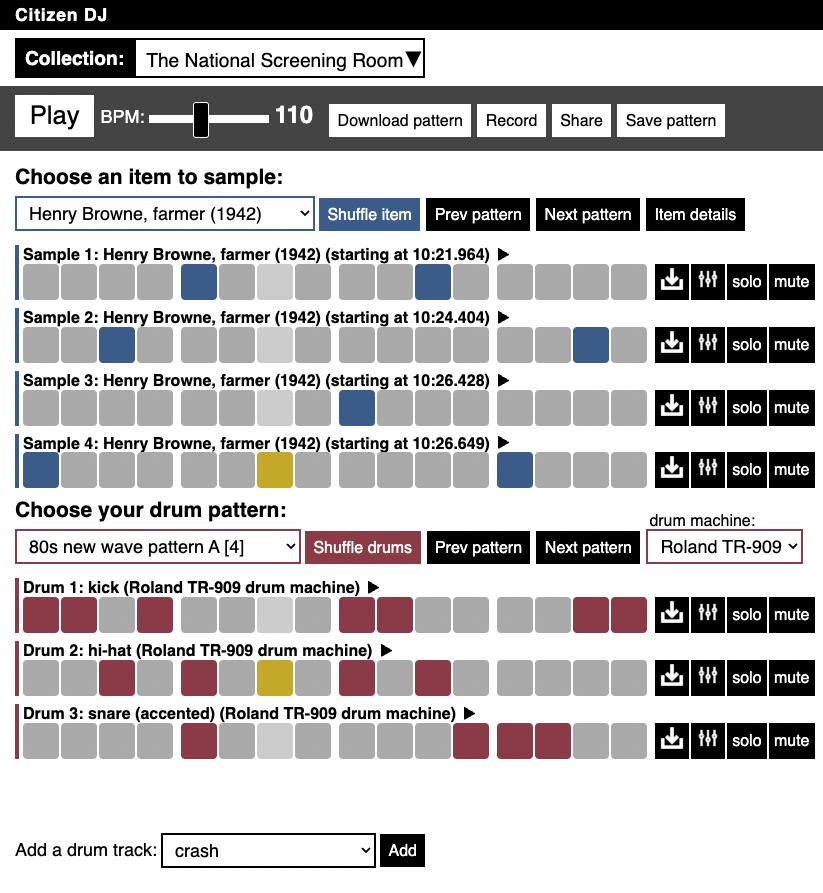
34 CMEA Magazine
New Ideas to Ponder…
2023 CMEA Research & Educational Projects Poster Session by Dr. Ruth Brittin, CMEA Research and Higher Education Representative
Welcome to the abstracts from the California All-State Conference this spring, presented annually by the Research and Higher Education Division of CMEA. This was a friendly, “come-and-go” session where presenters showcased their research and educational projects in the lobby of the convention center. We had a huge turn-out of attendees, as usual, leading to many great conversations, learning about each other’s work, finding new ideas, and building a network of music educators who can tap into each other’s work in the future. It was a great time to see old friends and make new ones. Here are the abstracts and contact information for each project presented at CASMEC; please read and learn about their projects. Feel free to contact them for their observations, data, or “myths” that inspired these projects, the concrete suggestions for best practice, and ideas for future projects or collaborations!
PRESENTERS
Ryan Abdelmalek, University of the Pacific Instrumental Conducting Curricula: The use of Supplementary Materials
Molly Bolewski, University of the Pacific
The Consistency of Choral Warm-Up Resources with the Literature on Appropriate Pedagogical Practices for Changing Voices: A Content Analysis
Ruth Brittin, University of the Pacific (co-authors: Deborah Confredo, John Geringer, Christopher Johnson, Joseph Parisi, Kevin Weingarten) Effects of Ensemble Performance Level and Phrasing on March Tempo Stability
Robert Brown, Weston Ranch High School Motivations, Must-Haves, and Methodology: A Study of Experienced Music Educators’ Experiences with Beginning Band Method Books
Jeremy Clifton, University of the Pacific Group Singing for Vocabulary Instruction
Zachary Clark, Indiana University
Openness, Mindfulness, and Diversity Orientation among PreService Music Educators
John Eros, California State University, East Bay
Contributions of California Authors to the Research Literature in Music Education
Michael Fleishman, College of the Desert
The “Research Riff:” Passion for Research through a Music Education Micro Journal
Megan Foley, Polytechnic School
Patriarchal Killjoys: The Experiences of Three (Women) University Band Directors
Jennifer Gee, San Diego State University
California Preservice Elementary Teachers and Music Integration in Elementary School Settings
Frank Heuser, Lily Chen-Hafteck, & Johanna Gamboa-Kroesen, UCLA
Examining Music Learning and Curricula from a Representational Perspective
Robert Huntington, Mendenhall Middle School
Composing as a Class, an Educational Project for Middle School Composition
Travis Maslen, Christian Brothers High School
Structured Band Arranging Template for Music Educators
Sophia Rechel, University of the Pacific
The Effects of Socioeconomic Status, Location, and Course Offerings on the Funding of Music Programs in Three Northern California Public School Districts
Julio Sequeira, University of Southern California
What Can We Learn from La Red de Escuelas de Música de Medellín?
Luis Talamantes, University of the Pacific
An Analysis of Mariachi Programs in the State of California
Anqi Tang, Rutgers, The State University of New Jersey
Application of Voice and Momentum Teaching in Musicianship Training for Applied University Music Education Majors
Spring Issue 2023 35
YOUR FUTURE BEGINS HERE
2023-2024
AUDITION DATES
November 4, 2023
February 10, 2024
March 2, 2024

DEGREE PROGRAMS
Bachelor of Music in Music Education (Choral, Instrumental, and Jazz tracks)


Bachelor of Music in Performance

Bachelor of Music in Jazz Studies

Bachelor of Music in Composition
Bachelor of Arts in Music
Minor in Music Liberal Arts
Minor in Music Jazz Studies


News from the California Choral Directors Association (CCDA)
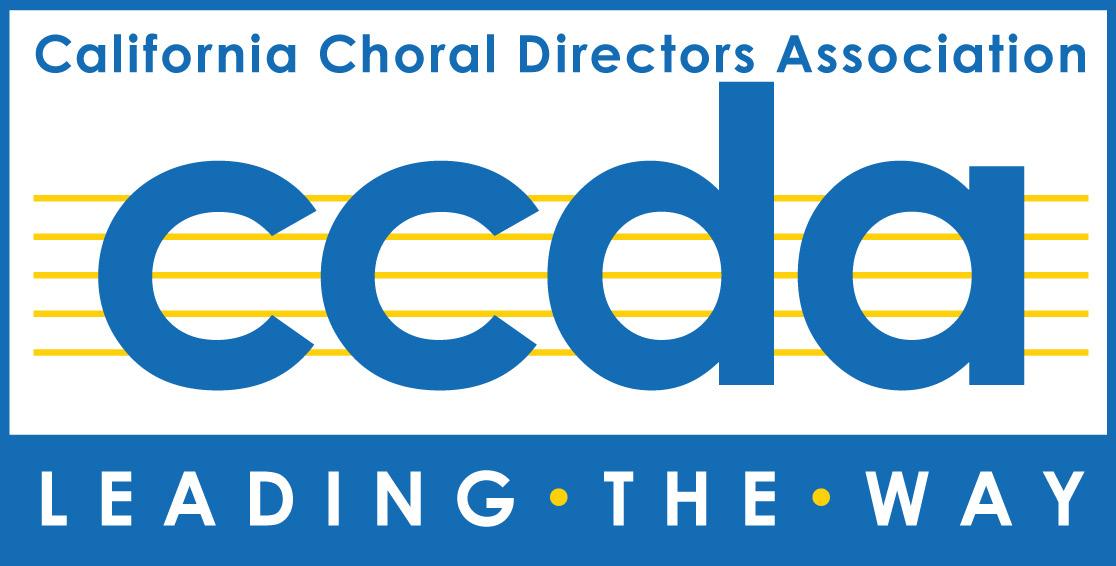 by Dr. Christopher Peterson, CCDA President
by Dr. Christopher Peterson, CCDA President
For more information about all our activities check us out at: https://www.calcda.org
It was wonderful to gather in Fresno once again for CASMEC last February. We proved once again that California music education is vibrant, growing, and at the very beginning of a golden age of music education in our schools. Proposition 28 will provide many millions of dollars for the Arts, and the moment we have long been hoping for has finally arrived; the Arts will finally be funded adequately in our state! CCDA will be working closely with our sister organizations to be sure that we seize the opportunities to change lives for the better though music.
The CCDA Board of Directors and staff members remain committed to championing policies and practices of equity that empower just, inclusive, and equitable communities. We have reviewed our organization’s bylaws to better address DEIA (Diversity, Equity, Inclusion, and Access) as well as gender issues. We have also created new opportunities to serve our constituents with scholarships and grants through our “Vision for the Future Fund” aimed at underserved populations and music students who need assistance accessing vocal music opportunities in our state. One concrete decision we made recently was to lower our participation fees for All-State Choirs. We continue to commission new works of choral music, and we stand committed to our mission to create transformative experiences for California’s diverse communities.
This July we will hold our annual summer Conference/Retreat at ECCO (Episcopal Conference Center Oakhurst) from July 23–26, 2023. It’s a conference. It’s a retreat. It’s a place to connect with choral musicians. It’s a place to reflect. It’s a venue to sing. It’s a time to learn. It’s an arena to laugh. It’s a forum to interact with those who know what you are going through. It’s ECCO, and it’s professional development unlike any other. We are planning to provide valuable resources to our attendees as we rebuild our ensembles, sing in person again, and continue to develop inclusion, access, and diversity in all levels of our ensembles. Our headliner will be Dr. Felicia Barber from Yale University. More information about all our conferences, honor choirs, and events can be found at our website: www.calcda.org
May you have a great end of your school year, a wonderful summer break, and a fabulous time next fall making music with your students. Be Well.

Higher Education Music Education
by Dr. Kara Ireland D’Ambrosio CMEA Higher Ed Music Education Supervisor Representative
Spring….Spring is so exciting. Our concerts, our children growing, our teacher candidates being hired for their first jobs… Spring! The CCTE (California Council on Teacher Education) just wrapped up their SPAN (Spring Policy Action Network) conference in Sacramento. The University Field Placement Forum held an incredible working group with 66 of our public school district personnel to build new pathways and best practices for teacher candidate field placements. The hope is to work closely with our district partners to provide strong mentor support for the teacher candidates and provide more placement opportunities for teacher candidates. I shared a memo to the State Superintendent Tony Thurmond and the State Board of Education about our work to streamline student teacher placements. We are working to establish a community forum online to support district and university partnerships and regional meetings to continue to build these important relationships.These are exciting times! Districts are excited to share and learn from the universities to create strong teacher pipelines, as well as the universities are willing to meet the needs of the districts to improve TK-12 students’ learning. I saw this picture that reminded me of these powerful relationships:
Isn’t it great that musicians love to work together and build relationships to make incredible music? I see these connections spreading to credential programs. Improving communication and realizing that districts and universities are part of the same orchestra - working to develop the next generation of teachers who will influence and grow our children. If you want to join our work at CCTE to improve student teaching placements, please contact me!
Dr. Kara Ireland D’Ambrosio Kara.IrelandDAmbrosio@sjsu.edu
Spring Issue 2023 37
Spring Update
by Tiffany Ou-Ponticelli,

CODA President

CODA is so proud of the four all-state orchestras who performed at CASMEC 2023 in February!

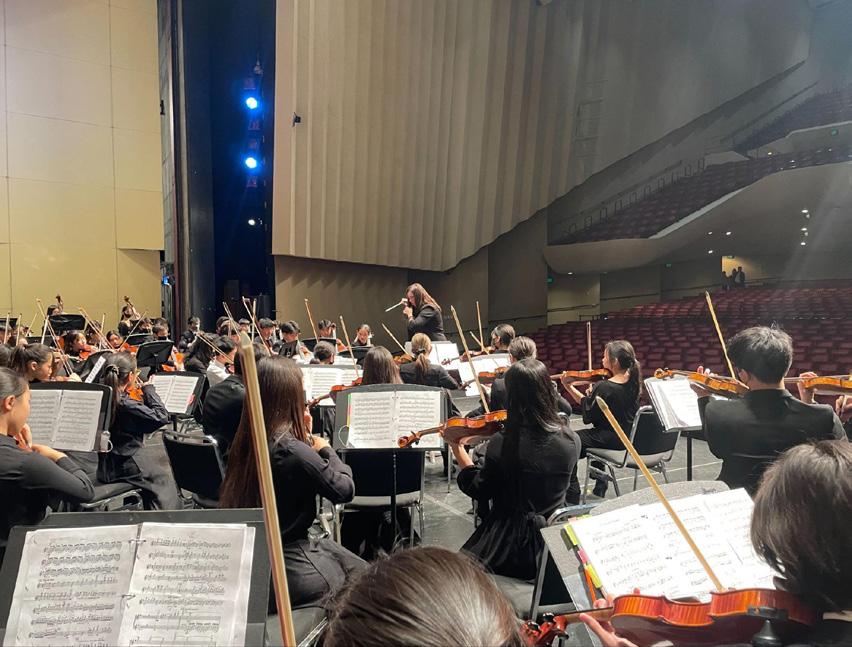
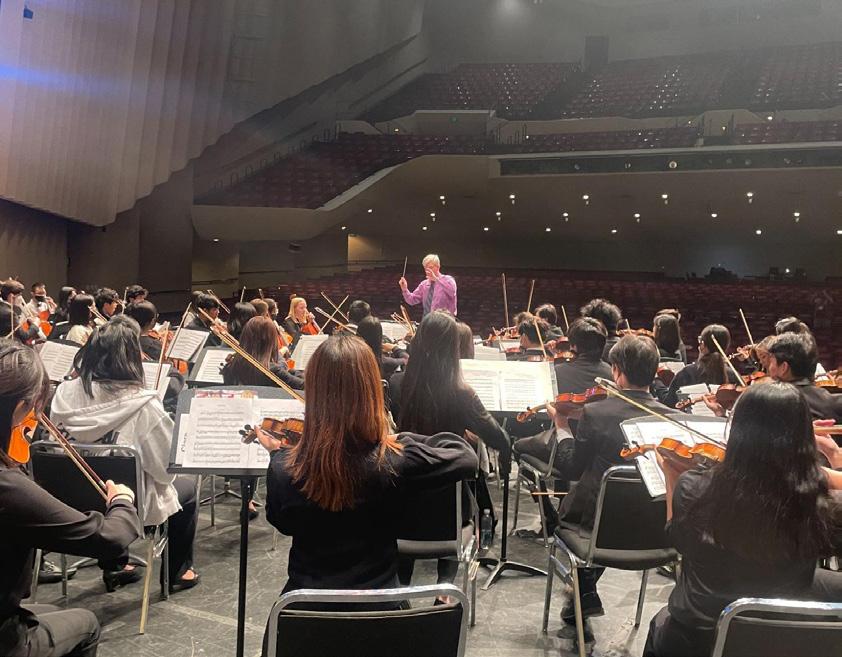
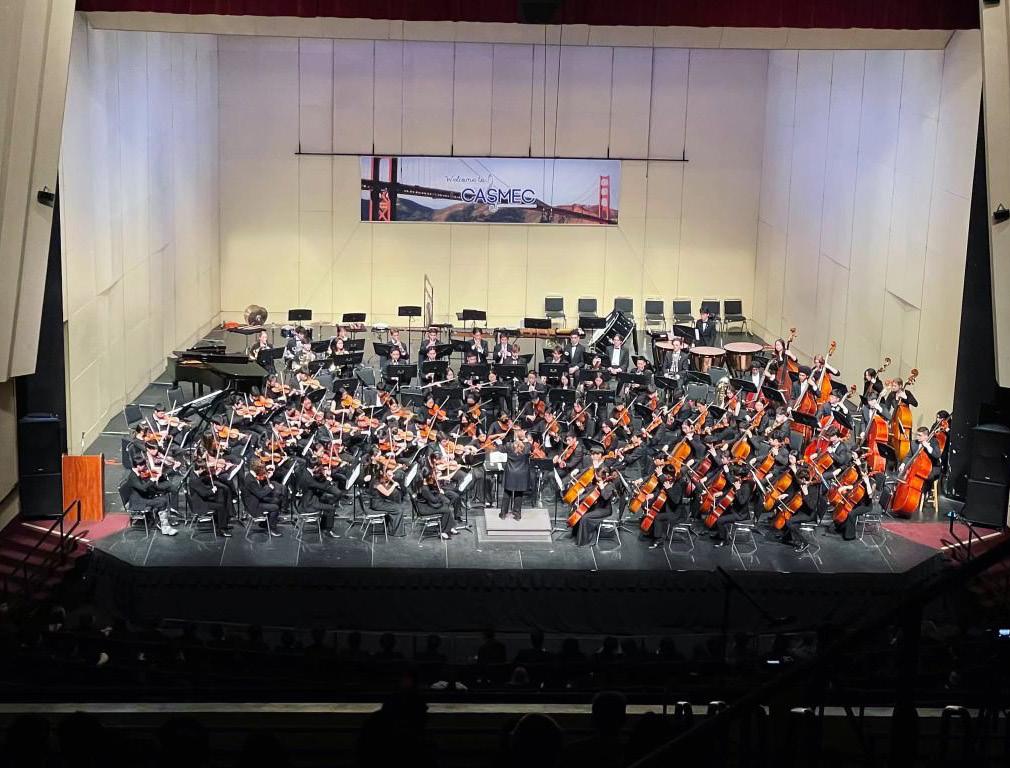
CODA Members - keep an eye out on your inbox for audition information regarding CODA December Honor Orchestra (Dec 1-2, 2023 at Stanford University) and All-State 2024 (January 31-February 4, 2024 in Sacramento). Stay connected with the California Orchestra Directors Association throughout the year. Follow us on Instagram, Facebook, and via our



 The All-State HS Symphony Orchestra under the baton of Gisele Ben-Dor.
The All-State JHS String Orchestra under the baton of Angela Ammerman.
The All-State JHS Concert Orchestra under the baton of Adrian Gordon.
The All-State HS Symphony Orchestra under the baton of Gisele Ben-Dor.
The All-State JHS String Orchestra under the baton of Angela Ammerman.
The All-State JHS Concert Orchestra under the baton of Adrian Gordon.
38 CMEA Magazine
The All-State HS String Orchestra under the baton of Mark Laycock.
COLLECT • SHARE • INSPIRE
CONGRATULATIONS!
Capistrano Valley H.S. Instrumental Music

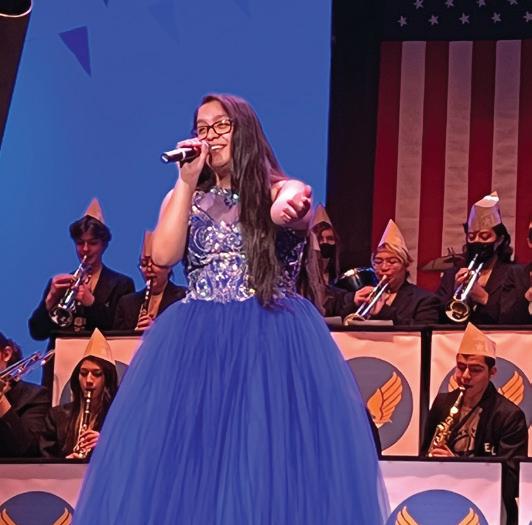


San Juan Capistrano, CA “Musical Mentors”
APPLICATIONS OPEN THIS SPRING
The Advocacy in Action Awards program is designed to collect, recognize, and share effective practices and initiatives that support music education in our schools. We hope that by celebrating these programs, we can inspire others to lead by example and take action in their own programs and communities.
VISIT ADVOCACY.MUSICFORALL.ORG


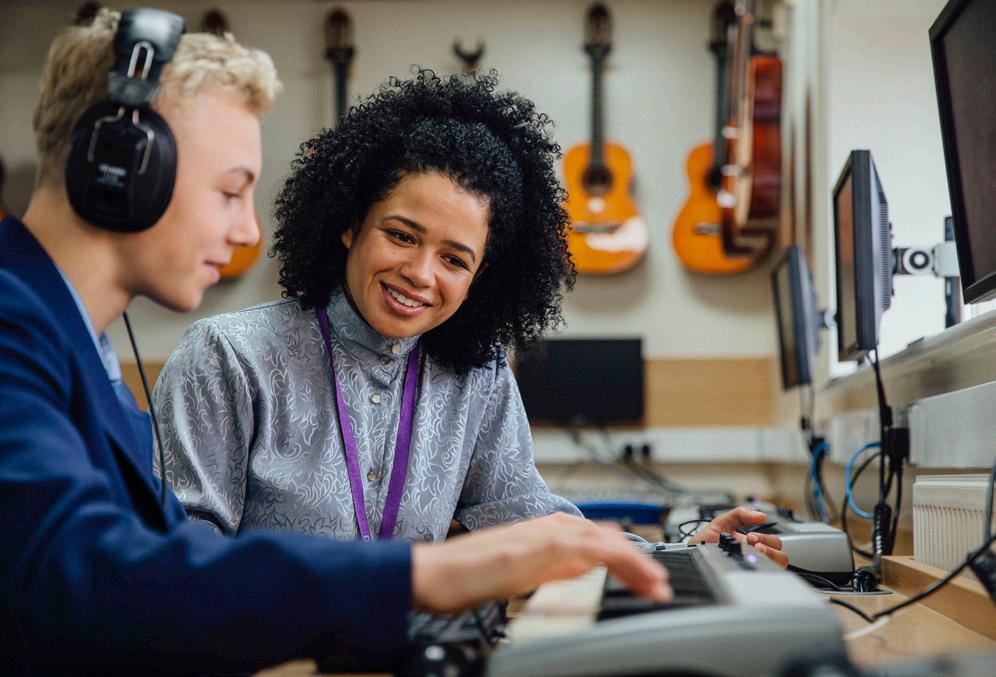


Ensuring all California students have equal access to a high-quality music education as part of a wellrounded education. https://calmusiced.com/ CALIFORNIA MUSIC EDUCATORS ASSOCIATION





















































































































 Sam Oh
Sam Oh










 by Daniel Crispino, Caitlin Cooper, & Victoria Guerrero
by Daniel Crispino, Caitlin Cooper, & Victoria Guerrero



 by David Green, CBDA Director of Communications
by David Green, CBDA Director of Communications













 by Dr. Christopher Peterson, CCDA President
by Dr. Christopher Peterson, CCDA President










 The All-State HS Symphony Orchestra under the baton of Gisele Ben-Dor.
The All-State JHS String Orchestra under the baton of Angela Ammerman.
The All-State JHS Concert Orchestra under the baton of Adrian Gordon.
The All-State HS Symphony Orchestra under the baton of Gisele Ben-Dor.
The All-State JHS String Orchestra under the baton of Angela Ammerman.
The All-State JHS Concert Orchestra under the baton of Adrian Gordon.

























